

Advancing medicines for breast cancer and beyond Corporate Overview October 2025
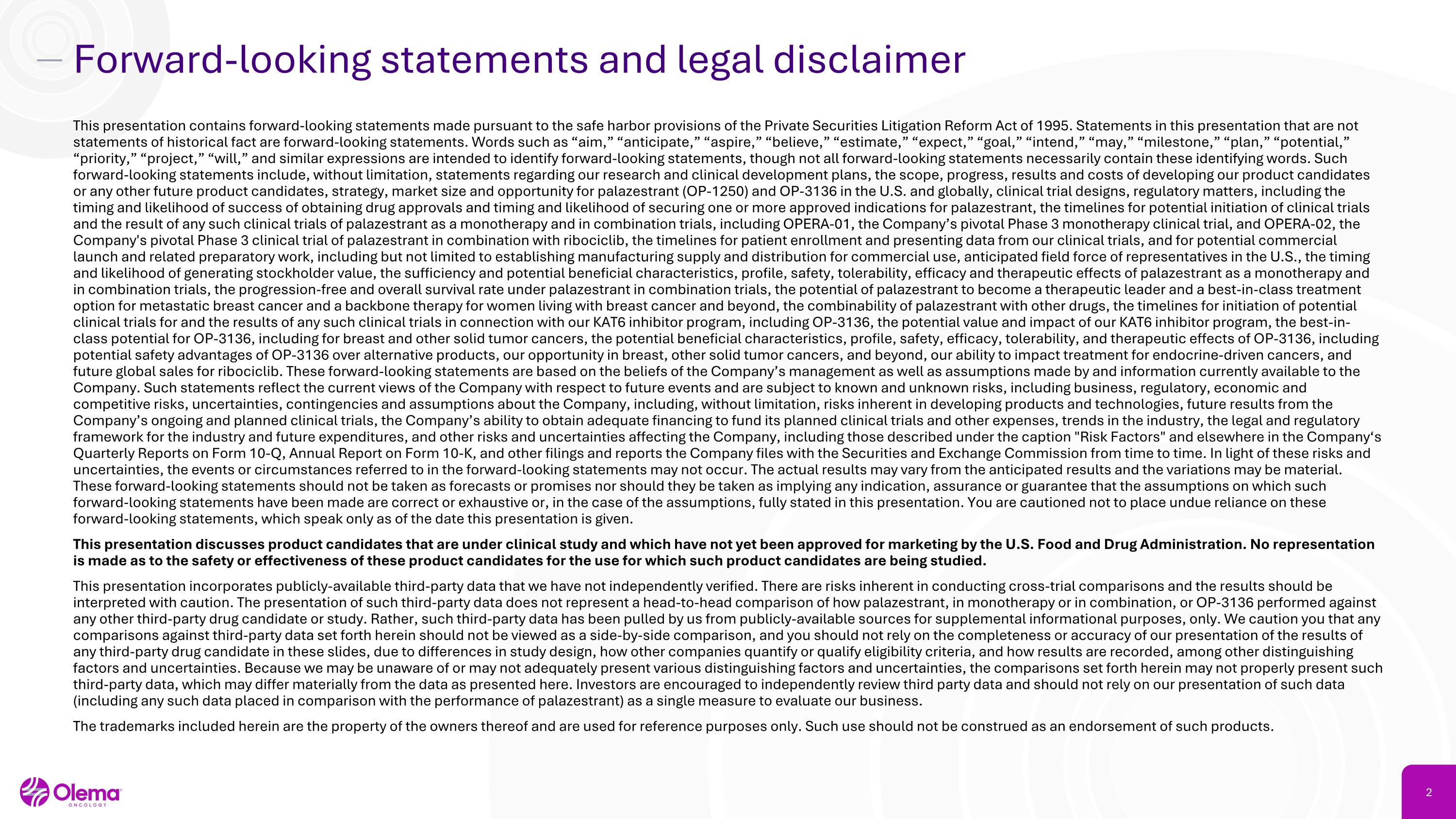
Forward-looking statements and legal disclaimer This presentation contains forward-looking statements made pursuant to the safe harbor provisions of the Private Securities Litigation Reform Act of 1995. Statements in this presentation that are not statements of historical fact are forward-looking statements. Words such as “aim,” “anticipate,” “aspire,” “believe,” “estimate,” “expect,” “goal,” “intend,” “may,” “milestone,” “plan,” “potential,” “priority,” “project,” “will,” and similar expressions are intended to identify forward-looking statements, though not all forward-looking statements necessarily contain these identifying words. Such forward-looking statements include, without limitation, statements regarding our research and clinical development plans, the scope, progress, results and costs of developing our product candidates or any other future product candidates, strategy, market size and opportunity for palazestrant (OP-1250) and OP-3136 in the U.S. and globally, clinical trial designs, regulatory matters, including the timing and likelihood of success of obtaining drug approvals and timing and likelihood of securing one or more approved indications for palazestrant, the timelines for potential initiation of clinical trials and the result of any such clinical trials of palazestrant as a monotherapy and in combination trials, including OPERA-01, the Company’s pivotal Phase 3 monotherapy clinical trial, and OPERA-02, the Company's pivotal Phase 3 clinical trial of palazestrant in combination with ribociclib, the timelines for patient enrollment and presenting data from our clinical trials, and for potential commercial launch and related preparatory work, including but not limited to establishing manufacturing supply and distribution for commercial use, anticipated field force of representatives in the U.S., the timing and likelihood of generating stockholder value, the sufficiency and potential beneficial characteristics, profile, safety, tolerability, efficacy and therapeutic effects of palazestrant as a monotherapy and in combination trials, the progression-free and overall survival rate under palazestrant in combination trials, the potential of palazestrant to become a therapeutic leader and a best-in-class treatment option for metastatic breast cancer and a backbone therapy for women living with breast cancer and beyond, the combinability of palazestrant with other drugs, the timelines for initiation of potential clinical trials for and the results of any such clinical trials in connection with our KAT6 inhibitor program, including OP-3136, the potential value and impact of our KAT6 inhibitor program, the best-in-class potential for OP-3136, including for breast and other solid tumor cancers, the potential beneficial characteristics, profile, safety, efficacy, tolerability, and therapeutic effects of OP-3136, including potential safety advantages of OP-3136 over alternative products, our opportunity in breast, other solid tumor cancers, and beyond, our ability to impact treatment for endocrine-driven cancers, and future global sales for ribociclib. These forward-looking statements are based on the beliefs of the Company’s management as well as assumptions made by and information currently available to the Company. Such statements reflect the current views of the Company with respect to future events and are subject to known and unknown risks, including business, regulatory, economic and competitive risks, uncertainties, contingencies and assumptions about the Company, including, without limitation, risks inherent in developing products and technologies, future results from the Company’s ongoing and planned clinical trials, the Company’s ability to obtain adequate financing to fund its planned clinical trials and other expenses, trends in the industry, the legal and regulatory framework for the industry and future expenditures, and other risks and uncertainties affecting the Company, including those described under the caption "Risk Factors" and elsewhere in the Company‘s Quarterly Reports on Form 10-Q, Annual Report on Form 10-K, and other filings and reports the Company files with the Securities and Exchange Commission from time to time. In light of these risks and uncertainties, the events or circumstances referred to in the forward-looking statements may not occur. The actual results may vary from the anticipated results and the variations may be material. These forward-looking statements should not be taken as forecasts or promises nor should they be taken as implying any indication, assurance or guarantee that the assumptions on which such forward-looking statements have been made are correct or exhaustive or, in the case of the assumptions, fully stated in this presentation. You are cautioned not to place undue reliance on these forward-looking statements, which speak only as of the date this presentation is given. This presentation discusses product candidates that are under clinical study and which have not yet been approved for marketing by the U.S. Food and Drug Administration. No representation is made as to the safety or effectiveness of these product candidates for the use for which such product candidates are being studied. This presentation incorporates publicly-available third-party data that we have not independently verified. There are risks inherent in conducting cross-trial comparisons and the results should be interpreted with caution. The presentation of such third-party data does not represent a head-to-head comparison of how palazestrant, in monotherapy or in combination, or OP-3136 performed against any other third-party drug candidate or study. Rather, such third-party data has been pulled by us from publicly-available sources for supplemental informational purposes, only. We caution you that any comparisons against third-party data set forth herein should not be viewed as a side-by-side comparison, and you should not rely on the completeness or accuracy of our presentation of the results of any third-party drug candidate in these slides, due to differences in study design, how other companies quantify or qualify eligibility criteria, and how results are recorded, among other distinguishing factors and uncertainties. Because we may be unaware of or may not adequately present various distinguishing factors and uncertainties, the comparisons set forth herein may not properly present such third-party data, which may differ materially from the data as presented here. Investors are encouraged to independently review third party data and should not rely on our presentation of such data (including any such data placed in comparison with the performance of palazestrant) as a single measure to evaluate our business. The trademarks included herein are the property of the owners thereof and are used for reference purposes only. Such use should not be construed as an endorsement of such products.
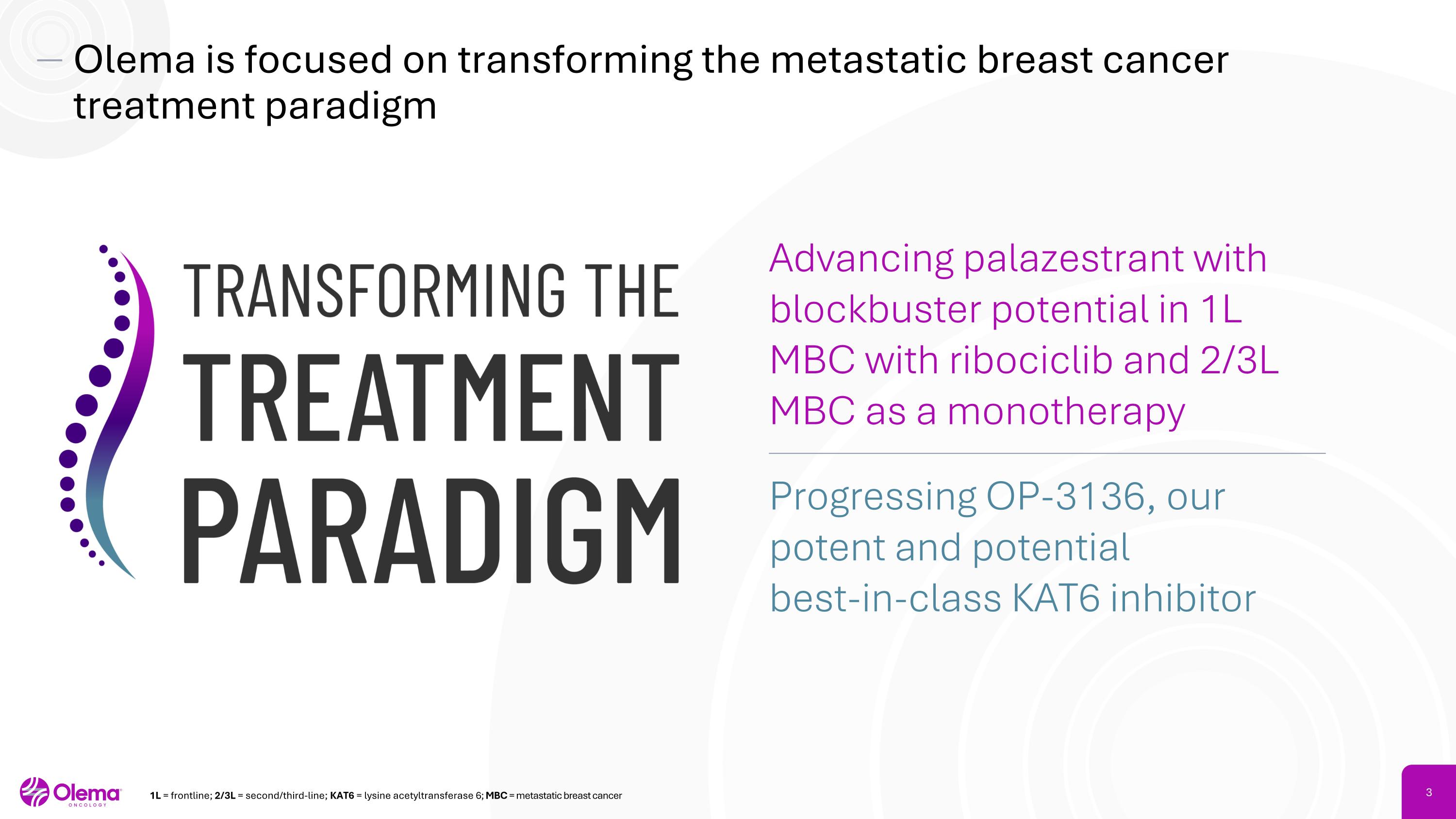
Olema is focused on transforming the metastatic breast cancer treatment paradigm Advancing palazestrant with blockbuster potential in 1L MBC with ribociclib and 2/3L MBC as a monotherapy 1L = frontline; 2/3L = second/third-line; KAT6 = lysine acetyltransferase 6; MBC = metastatic breast cancer Progressing OP-3136, our potent and potential best-in-class KAT6 inhibitor
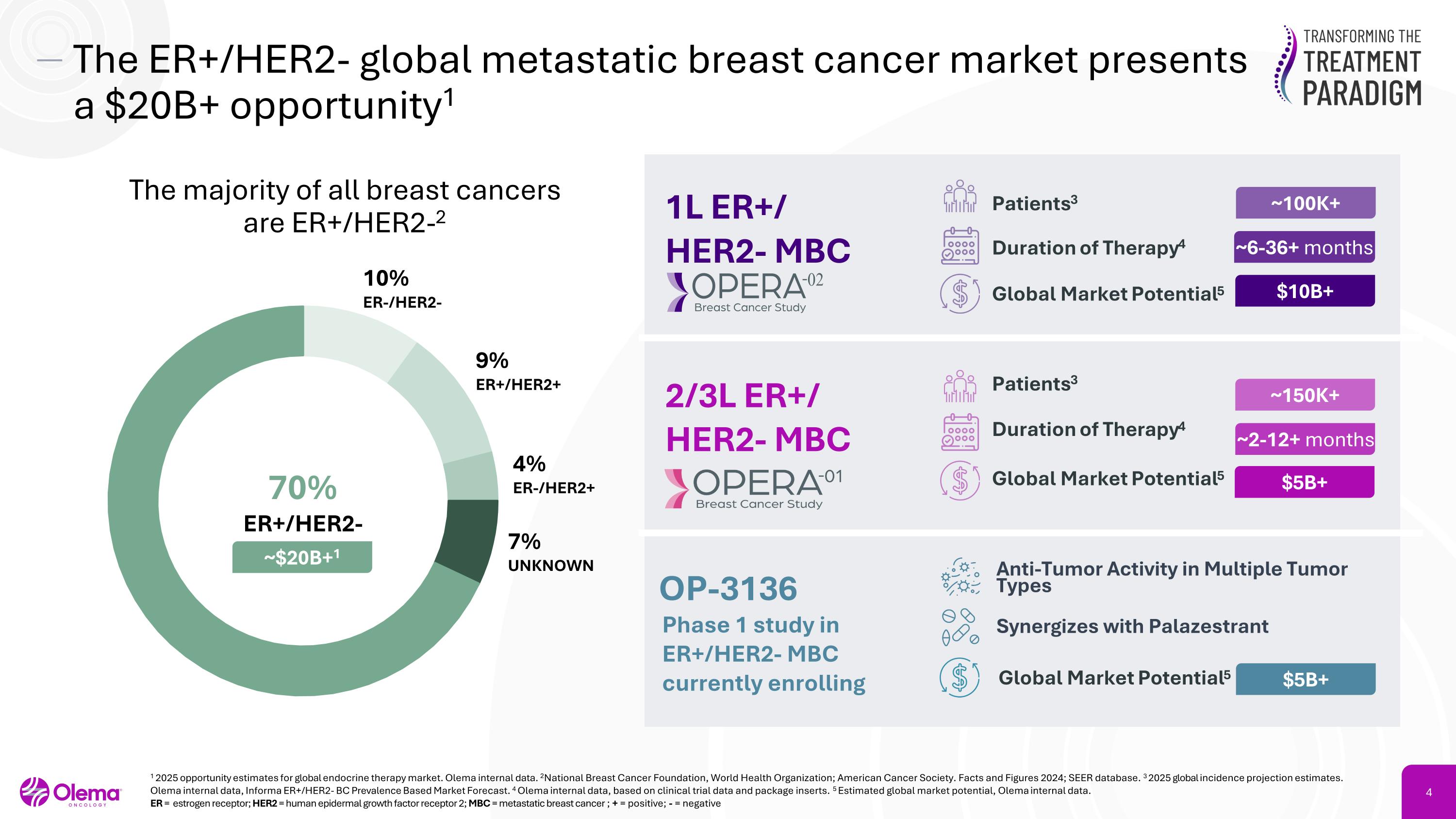
The ER+/HER2- global metastatic breast cancer market presents a $20B+ opportunity1 1 2025 opportunity estimates for global endocrine therapy market. Olema internal data. 2National Breast Cancer Foundation, World Health Organization; American Cancer Society. Facts and Figures 2024; SEER database. 3 2025 global incidence projection estimates. Olema internal data, Informa ER+/HER2- BC Prevalence Based Market Forecast. 4 Olema internal data, based on clinical trial data and package inserts. 5 Estimated global market potential, Olema internal data. ER = estrogen receptor; HER2 = human epidermal growth factor receptor 2; MBC = metastatic breast cancer ; + = positive; - = negative The majority of all breast cancers are ER+/HER2-2 2/3L ER+/ HER2- MBC Patients3 ~150K+ Duration of Therapy4 ~2-12+ months Global Market Potential5 $5B+ 1L ER+/ HER2- MBC Patients3 ~100K+ Duration of Therapy4 ~6-36+ months Global Market Potential5 $10B+ OP-3136 Phase 1 study in ER+/HER2- MBC currently enrolling 70% ER+/HER2- 10% ER-/HER2- 9% ER+/HER2+ 4% ER-/HER2+ 7% UNKNOWN Anti-Tumor Activity in Multiple Tumor Types Synergizes with Palazestrant ~$20B+1 Global Market Potential5 $5B+
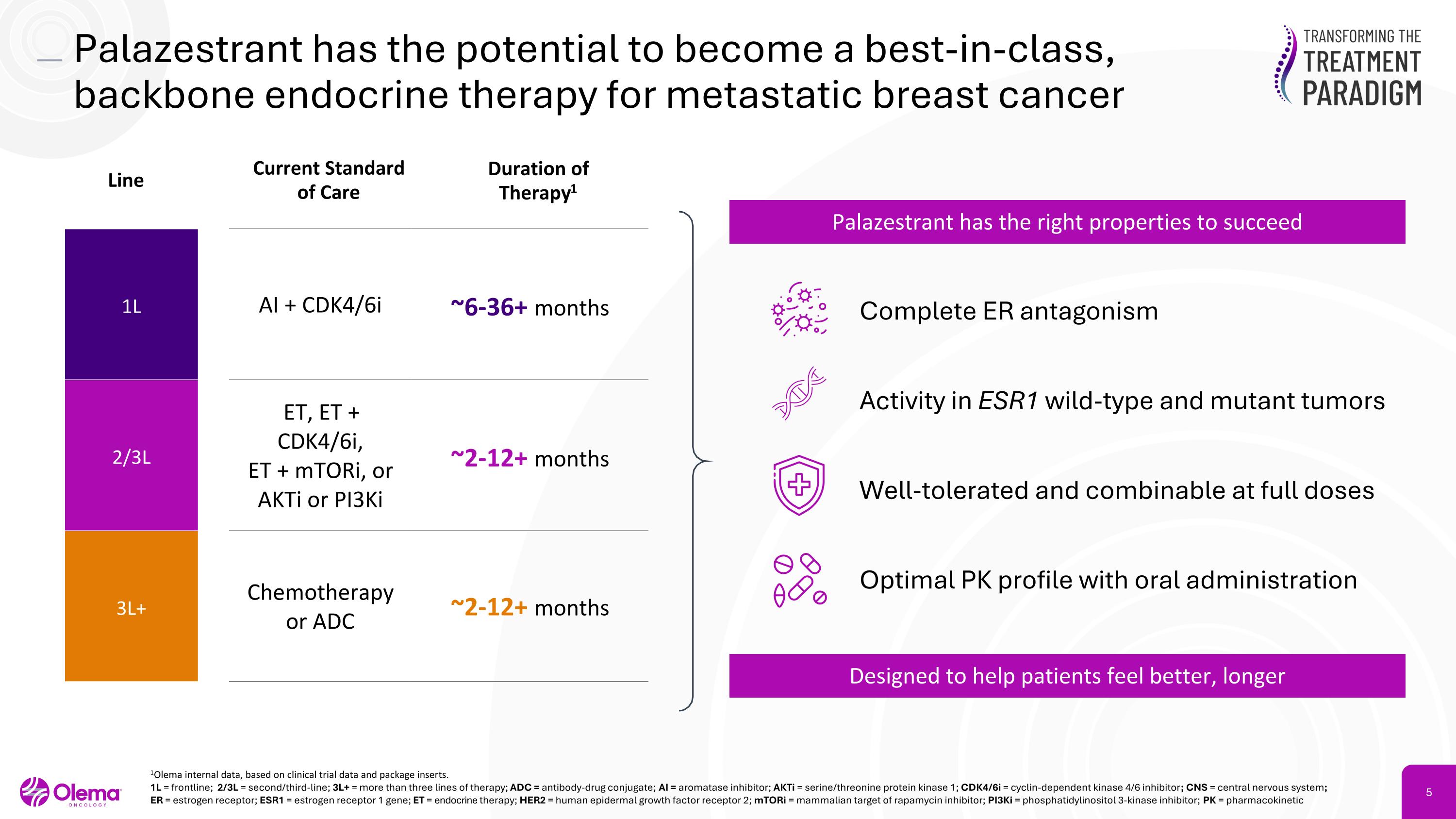
Complete ER antagonism Activity in ESR1 wild-type and mutant tumors Well-tolerated and combinable at full doses Optimal PK profile with oral administration Palazestrant has the potential to become a best-in-class, backbone endocrine therapy for metastatic breast cancer AI + CDK4/6i ~6-36+ months ET, ET + CDK4/6i, ET + mTORi, or AKTi or PI3Ki ~2-12+ months Chemotherapy or ADC ~2-12+ months 1L 2/3L 3L+ Designed to help patients feel better, longer Current Standard of Care 1Olema internal data, based on clinical trial data and package inserts. 1L = frontline; 2/3L = second/third-line; 3L+ = more than three lines of therapy; ADC = antibody-drug conjugate; AI = aromatase inhibitor; AKTi = serine/threonine protein kinase 1; CDK4/6i = cyclin-dependent kinase 4/6 inhibitor; CNS = central nervous system; ER = estrogen receptor; ESR1 = estrogen receptor 1 gene; ET = endocrine therapy; HER2 = human epidermal growth factor receptor 2; mTORi = mammalian target of rapamycin inhibitor; PI3Ki = phosphatidylinositol 3-kinase inhibitor; PK = pharmacokinetic Duration of Therapy1 Line Palazestrant has the right properties to succeed
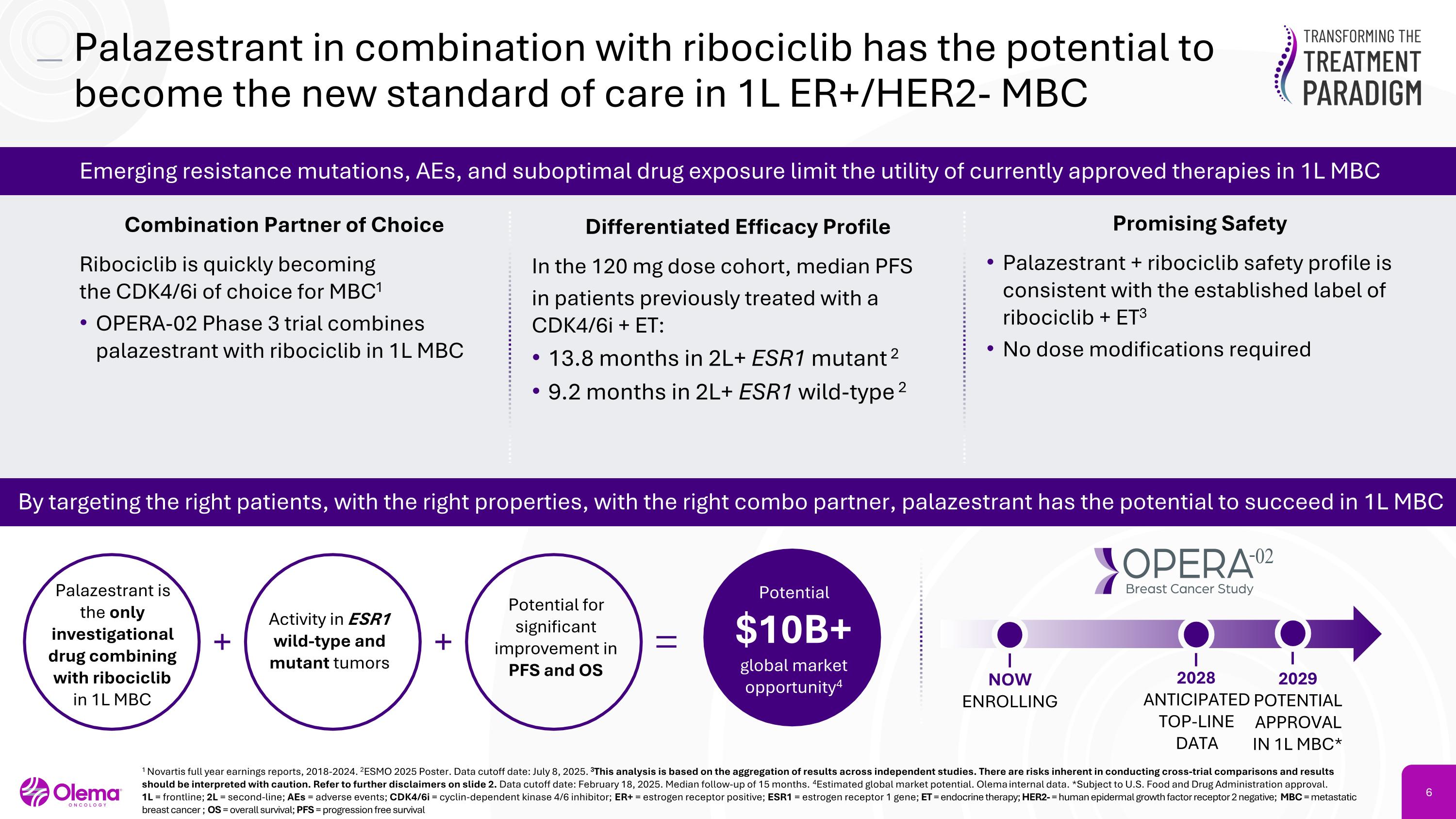
Emerging resistance mutations, AEs, and suboptimal drug exposure limit the utility of currently approved therapies in 1L MBC Palazestrant in combination with ribociclib has the potential to become the new standard of care in 1L ER+/HER2- MBC 1 Novartis full year earnings reports, 2018-2024. 2ESMO 2025 Poster. Data cutoff date: July 8, 2025. 3This analysis is based on the aggregation of results across independent studies. There are risks inherent in conducting cross-trial comparisons and results should be interpreted with caution. Refer to further disclaimers on slide 2. Data cutoff date: February 18, 2025. Median follow-up of 15 months. 4Estimated global market potential. Olema internal data. *Subject to U.S. Food and Drug Administration approval. 1L = frontline; 2L = second-line; AEs = adverse events; CDK4/6i = cyclin-dependent kinase 4/6 inhibitor; ER+ = estrogen receptor positive; ESR1 = estrogen receptor 1 gene; ET = endocrine therapy; HER2- = human epidermal growth factor receptor 2 negative; MBC = metastatic breast cancer ; OS = overall survival; PFS = progression free survival By targeting the right patients, with the right properties, with the right combo partner, palazestrant has the potential to succeed in 1L MBC NOW ENROLLING 2028 ANTICIPATED TOP-LINE DATA 2029 POTENTIAL APPROVAL IN 1L MBC* Palazestrant is the only investigational drug combining with ribociclib in 1L MBC Activity in ESR1 wild-type and mutant tumors Potential for significant improvement in PFS and OS Potential $10B+ global market opportunity4 Differentiated Efficacy Profile In the 120 mg dose cohort, median PFS in patients previously treated with a CDK4/6i + ET: 13.8 months in 2L+ ESR1 mutant 2 9.2 months in 2L+ ESR1 wild-type 2 Combination Partner of Choice Ribociclib is quickly becoming the CDK4/6i of choice for MBC1 OPERA-02 Phase 3 trial combines palazestrant with ribociclib in 1L MBC Promising Safety Palazestrant + ribociclib safety profile is consistent with the established label of ribociclib + ET3 No dose modifications required
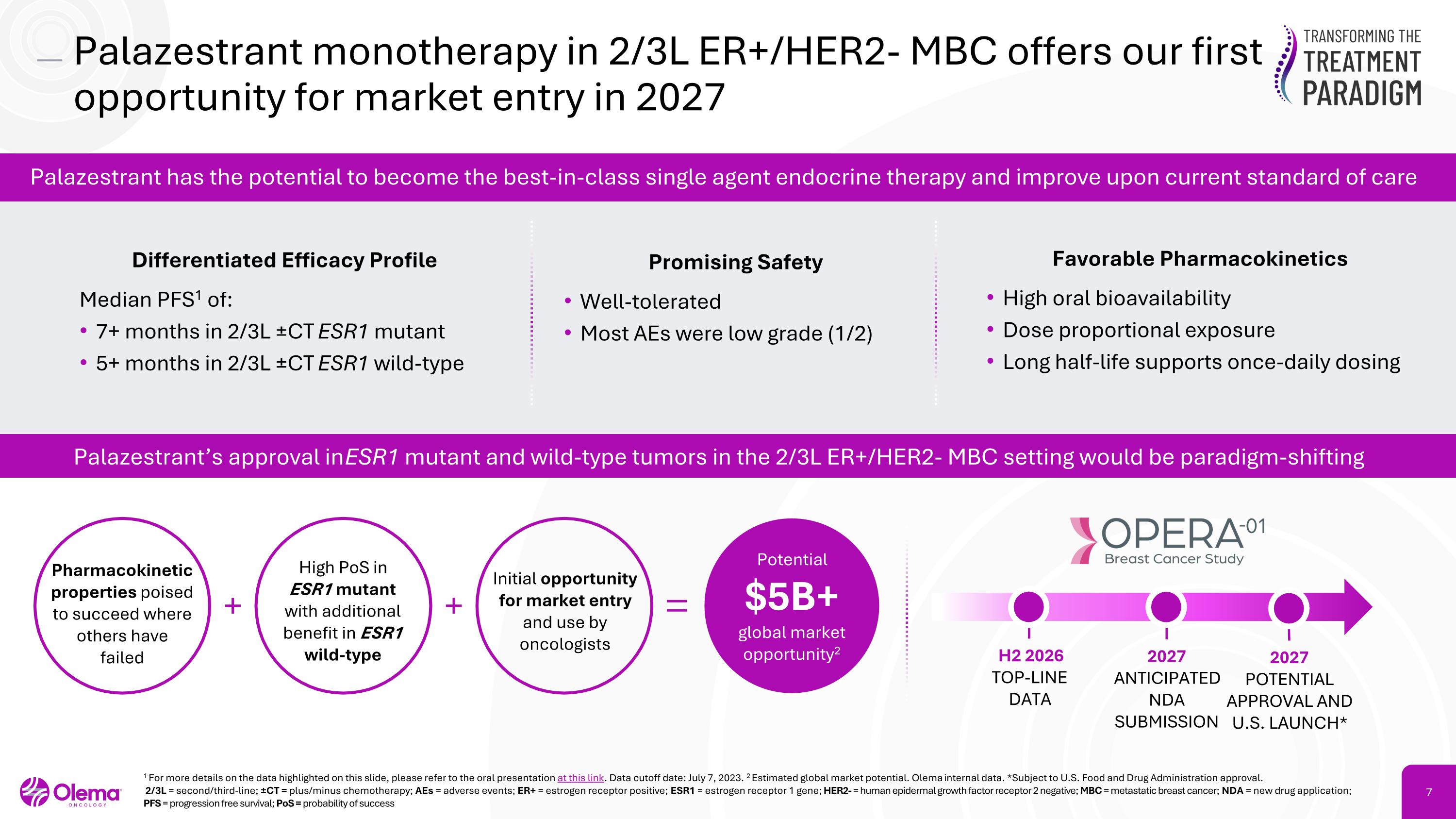
Palazestrant monotherapy in 2/3L ER+/HER2- MBC offers our first opportunity for market entry in 2027 Promising Safety Well-tolerated Most AEs were low grade (1/2) Differentiated Efficacy Profile Median PFS1 of: 7+ months in 2/3L ±CT ESR1 mutant 5+ months in 2/3L ±CT ESR1 wild-type Favorable Pharmacokinetics High oral bioavailability Dose proportional exposure Long half-life supports once-daily dosing H2 2026 TOP-LINE DATA 2027 ANTICIPATED NDA SUBMISSION 2027 POTENTIAL APPROVAL AND U.S. LAUNCH* Palazestrant has the potential to become the best-in-class single agent endocrine therapy and improve upon current standard of care High PoS in ESR1 mutant with additional benefit in ESR1 wild-type Pharmacokinetic properties poised to succeed where others have failed Potential $5B+ global market opportunity2 1 For more details on the data highlighted on this slide, please refer to the oral presentation at this link. Data cutoff date: July 7, 2023. 2 Estimated global market potential. Olema internal data. *Subject to U.S. Food and Drug Administration approval. 2/3L = second/third-line; ±CT = plus/minus chemotherapy; AEs = adverse events; ER+ = estrogen receptor positive; ESR1 = estrogen receptor 1 gene; HER2- = human epidermal growth factor receptor 2 negative; MBC = metastatic breast cancer; NDA = new drug application; PFS = progression free survival; PoS = probability of success Palazestrant’s approval in ESR1 mutant and wild-type tumors in the 2/3L ER+/HER2- MBC setting would be paradigm-shifting Initial opportunity for market entry and use by oncologists
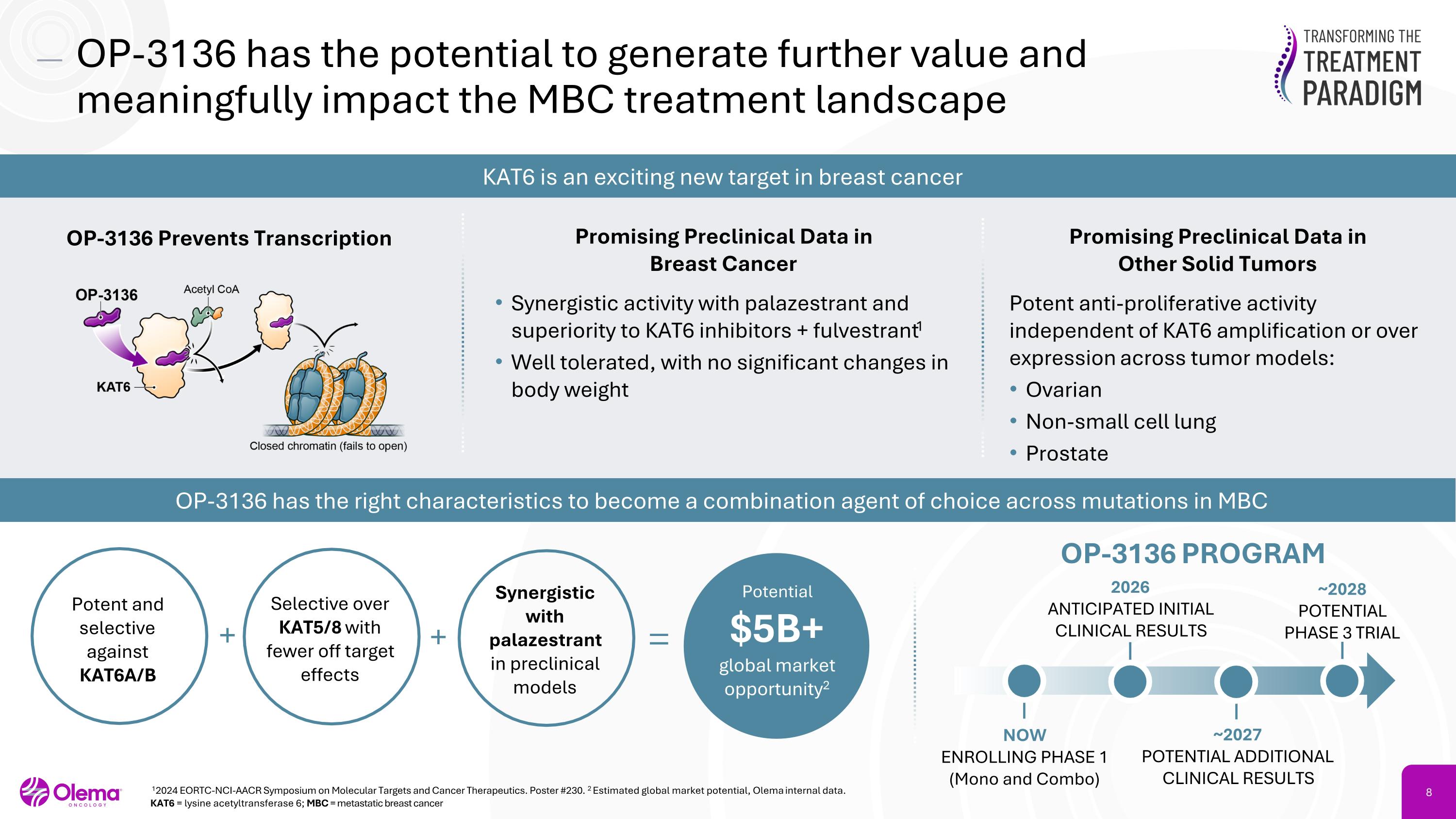
Potent and selective against KAT6A/B Selective over KAT5/8 with fewer off target effects Synergistic with palazestrant in preclinical models Potential $5B+ global market opportunity2 Promising Preclinical Data in Breast Cancer Synergistic activity with palazestrant and superiority to KAT6 inhibitors + fulvestrant1 Well tolerated, with no significant changes in body weight OP-3136 Prevents Transcription Promising Preclinical Data in Other Solid Tumors Potent anti-proliferative activity independent of KAT6 amplification or over expression across tumor models: Ovarian Non-small cell lung Prostate OP-3136 has the potential to generate further value and meaningfully impact the MBC treatment landscape 2026 ANTICIPATED INITIAL CLINICAL RESULTS ~2027 POTENTIAL ADDITIONAL CLINICAL RESULTS OP-3136 PROGRAM NOW ENROLLING PHASE 1 (Mono and Combo) ~2028 POTENTIAL PHASE 3 TRIAL KAT6 is an exciting new target in breast cancer 12024 EORTC-NCI-AACR Symposium on Molecular Targets and Cancer Therapeutics. Poster #230. 2 Estimated global market potential, Olema internal data. KAT6 = lysine acetyltransferase 6; MBC = metastatic breast cancer OP-3136 has the right characteristics to become a combination agent of choice across mutations in MBC
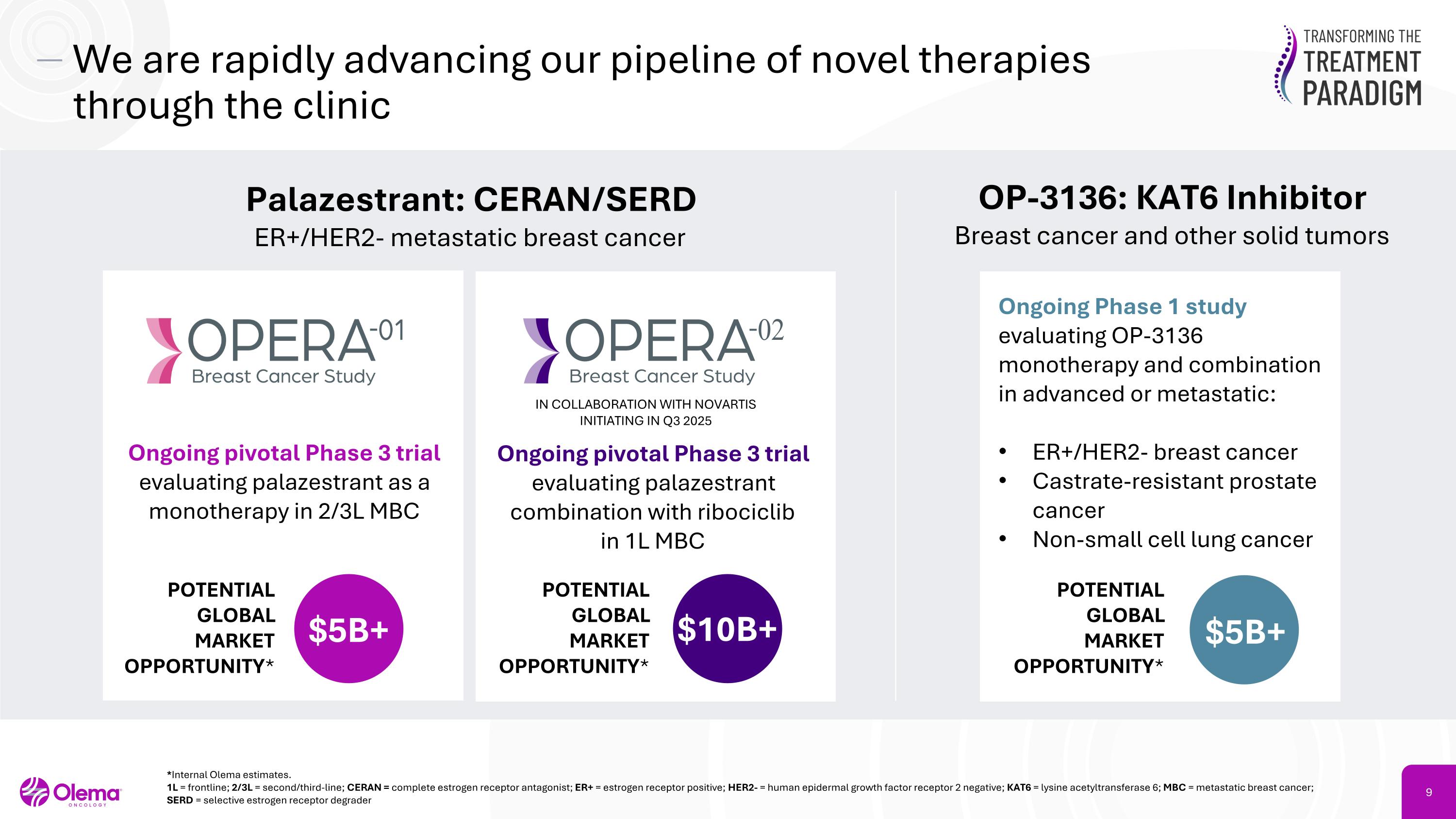
We are rapidly advancing our pipeline of novel therapies through the clinic Palazestrant: CERAN/SERD ER+/HER2- metastatic breast cancer OP-3136: KAT6 Inhibitor Breast cancer and other solid tumors Ongoing pivotal Phase 3 trial evaluating palazestrant combination with ribociclib in 1L MBC Ongoing pivotal Phase 3 trial evaluating palazestrant as a monotherapy in 2/3L MBC *Internal Olema estimates. 1L = frontline; 2/3L = second/third-line; CERAN = complete estrogen receptor antagonist; ER+ = estrogen receptor positive; HER2- = human epidermal growth factor receptor 2 negative; KAT6 = lysine acetyltransferase 6; MBC = metastatic breast cancer; SERD = selective estrogen receptor degrader $5B+ $10B+ POTENTIAL GLOBAL MARKET OPPORTUNITY* Ongoing Phase 1 study evaluating OP-3136 monotherapy and combination in advanced or metastatic: ER+/HER2- breast cancer Castrate-resistant prostate cancer Non-small cell lung cancer $5B+ IN COLLABORATION WITH NOVARTIS INITIATING IN Q3 2025 POTENTIAL GLOBAL MARKET OPPORTUNITY* POTENTIAL GLOBAL MARKET OPPORTUNITY*
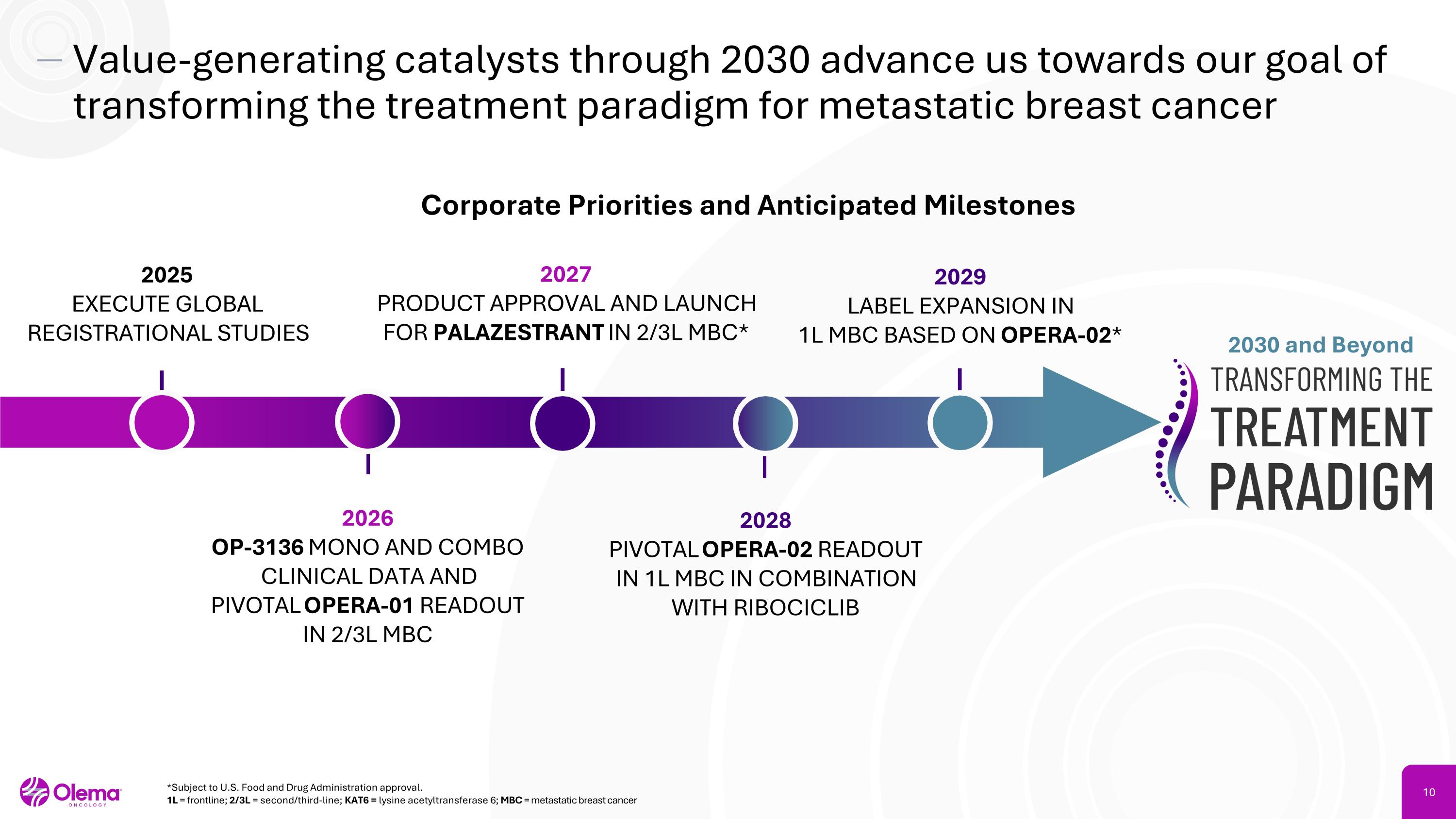
Value-generating catalysts through 2030 advance us towards our goal of transforming the treatment paradigm for metastatic breast cancer 2025 EXECUTE GLOBAL REGISTRATIONAL STUDIES 2027 PRODUCT APPROVAL AND LAUNCH FOR PALAZESTRANT IN 2/3L MBC* 2028 PIVOTAL OPERA-02 READOUT IN 1L MBC IN COMBINATION WITH RIBOCICLIB 2026 OP-3136 MONO AND COMBO CLINICAL DATA AND PIVOTAL OPERA-01 READOUT IN 2/3L MBC 2029 LABEL EXPANSION IN 1L MBC BASED ON OPERA-02* *Subject to U.S. Food and Drug Administration approval. 1L = frontline; 2/3L = second/third-line; KAT6 = lysine acetyltransferase 6; MBC = metastatic breast cancer 2030 and Beyond Corporate Priorities and Anticipated Milestones
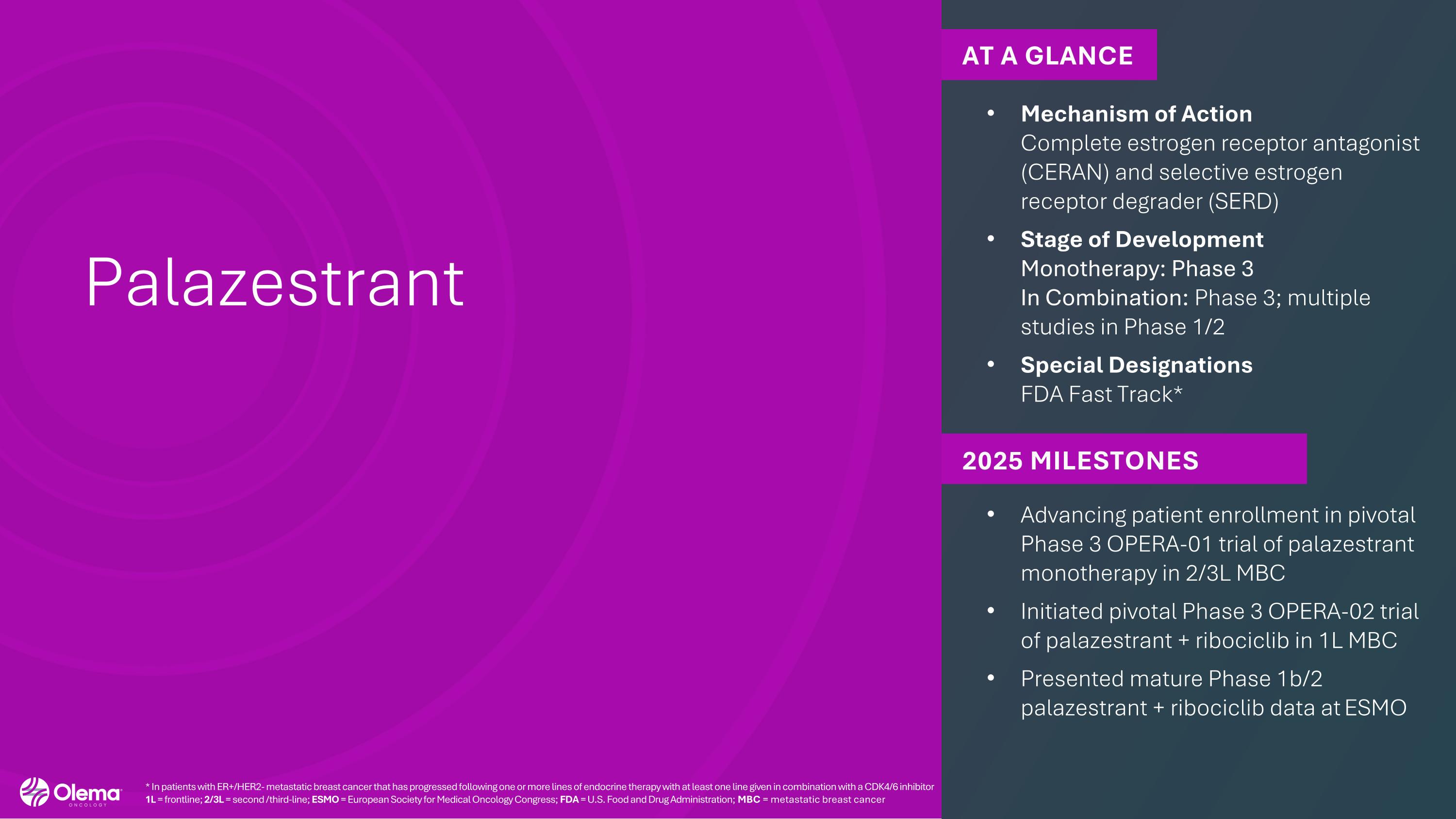
Palazestrant AT A GLANCE Mechanism of Action Complete estrogen receptor antagonist (CERAN) and selective estrogen receptor degrader (SERD) Stage of Development Monotherapy: Phase 3 In Combination: Phase 3; multiple studies in Phase 1/2 Special Designations FDA Fast Track* 2025 MILESTONES Advancing patient enrollment in pivotal Phase 3 OPERA-01 trial of palazestrant monotherapy in 2/3L MBC Initiated pivotal Phase 3 OPERA-02 trial of palazestrant + ribociclib in 1L MBC Presented mature Phase 1b/2 palazestrant + ribociclib data at ESMO * In patients with ER+/HER2- metastatic breast cancer that has progressed following one or more lines of endocrine therapy with at least one line given in combination with a CDK4/6 inhibitor 1L = frontline; 2/3L = second /third-line; ESMO = European Society for Medical Oncology Congress; FDA = U.S. Food and Drug Administration; MBC = metastatic breast cancer
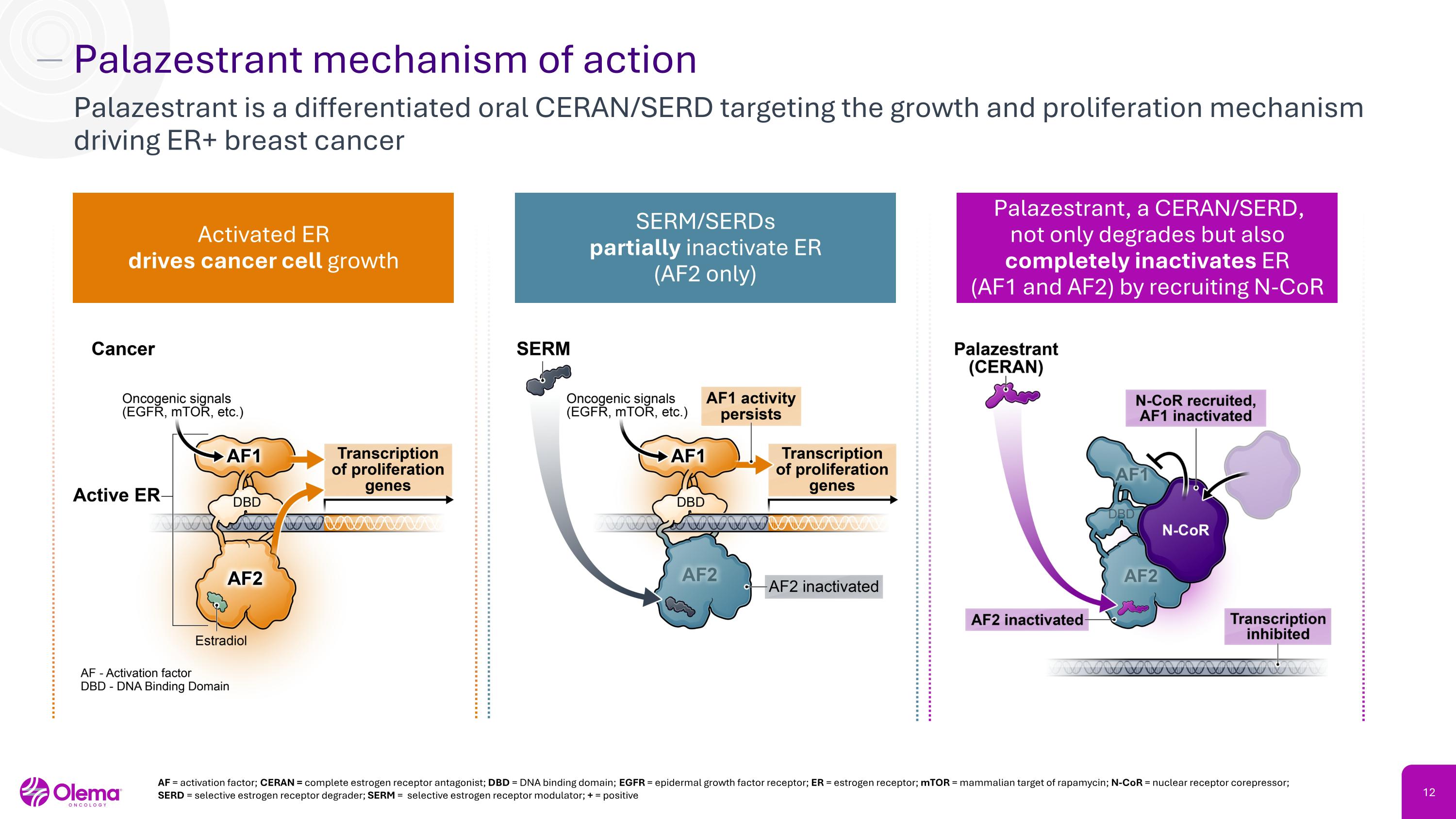
Palazestrant mechanism of action Palazestrant is a differentiated oral CERAN/SERD targeting the growth and proliferation mechanism driving ER+ breast cancer Activated ER drives cancer cell growth SERM/SERDs partially inactivate ER (AF2 only) Palazestrant, a CERAN/SERD, not only degrades but also completely inactivates ER (AF1 and AF2) by recruiting N-CoR AF = activation factor; CERAN = complete estrogen receptor antagonist; DBD = DNA binding domain; EGFR = epidermal growth factor receptor; ER = estrogen receptor; mTOR = mammalian target of rapamycin; N-CoR = nuclear receptor corepressor; SERD = selective estrogen receptor degrader; SERM = selective estrogen receptor modulator; + = positive
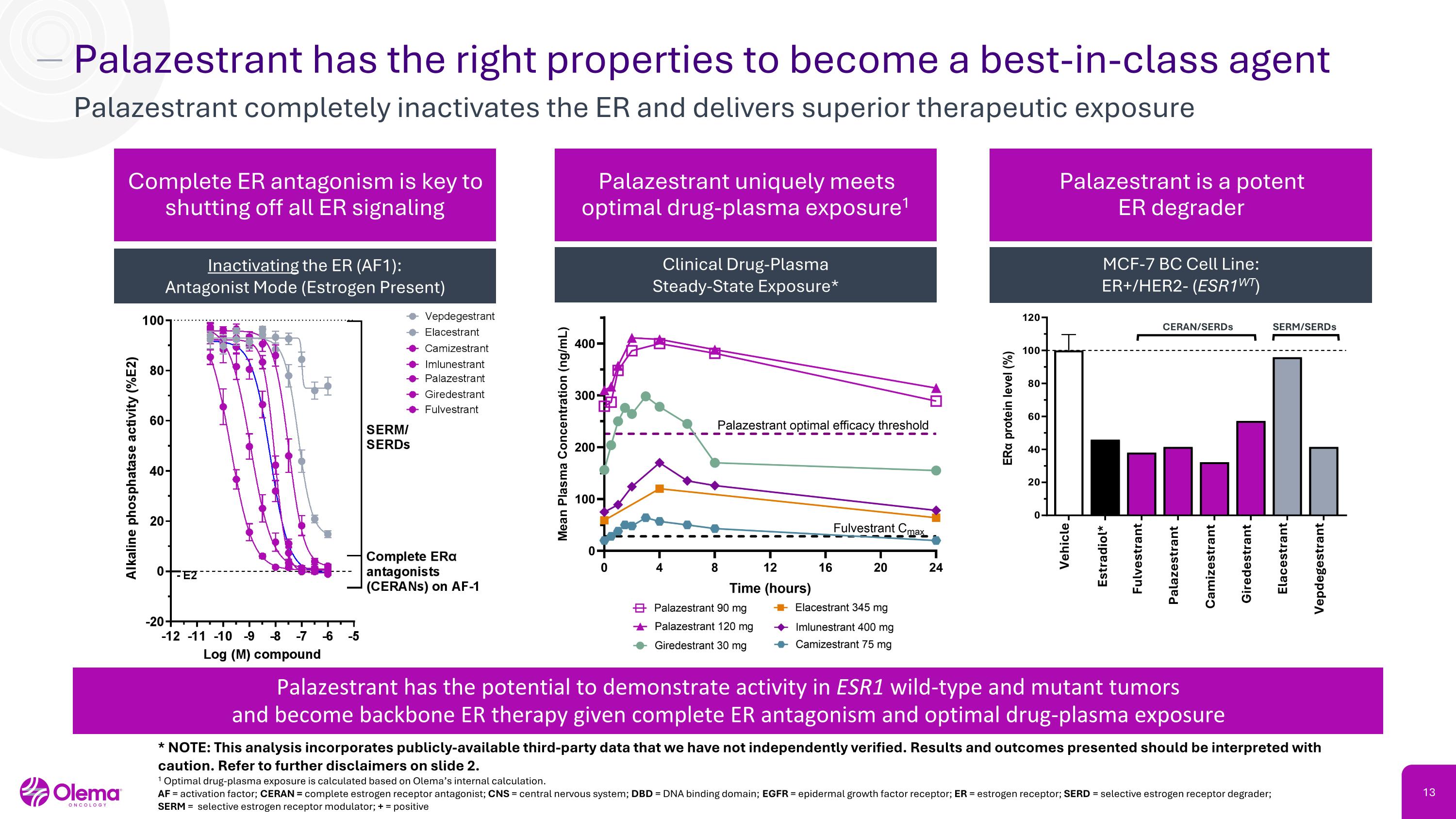
Palazestrant has the right properties to become a best-in-class agent Palazestrant completely inactivates the ER and delivers superior therapeutic exposure Complete ER antagonism is key to shutting off all ER signaling Palazestrant uniquely meets optimal drug-plasma exposure1 * NOTE: This analysis incorporates publicly-available third-party data that we have not independently verified. Results and outcomes presented should be interpreted with caution. Refer to further disclaimers on slide 2. 1 Optimal drug-plasma exposure is calculated based on Olema’s internal calculation. AF = activation factor; CERAN = complete estrogen receptor antagonist; CNS = central nervous system; DBD = DNA binding domain; EGFR = epidermal growth factor receptor; ER = estrogen receptor; SERD = selective estrogen receptor degrader; SERM = selective estrogen receptor modulator; + = positive Inactivating the ER (AF1): Antagonist Mode (Estrogen Present) Palazestrant is a potent ER degrader MCF-7 BC Cell Line: ER+/HER2- (ESR1WT) CERAN/SERDs SERM/SERDs Vehicle Estradiol* Fulvestrant Palazestrant Vepdegestrant Camizestrant Giredestrant Elacestrant Clinical Drug-Plasma Steady-State Exposure* Palazestrant has the potential to demonstrate activity in ESR1 wild-type and mutant tumors and become backbone ER therapy given complete ER antagonism and optimal drug-plasma exposure
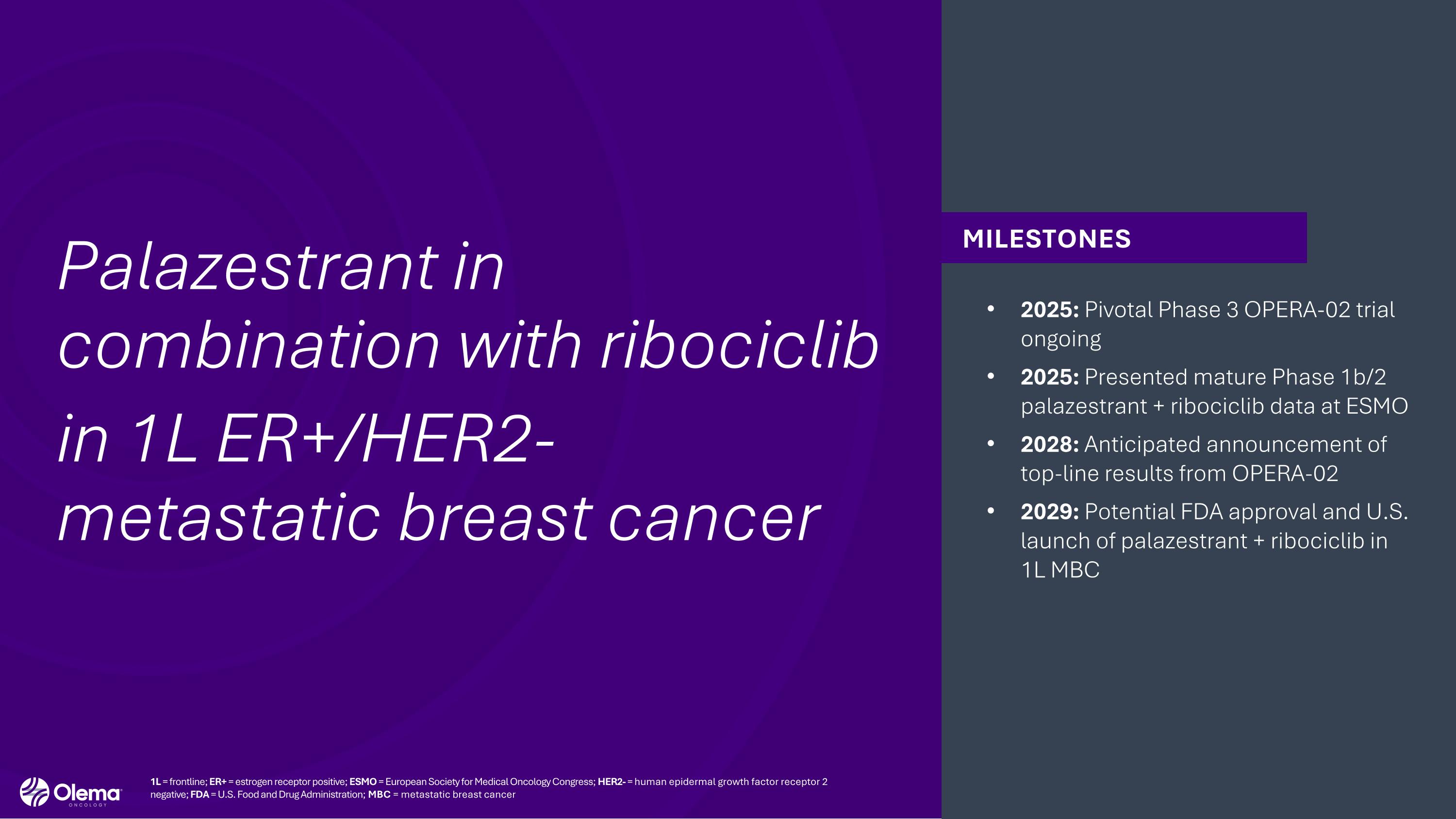
Palazestrant in combination with ribociclib in 1L ER+/HER2- metastatic breast cancer MILESTONES 2025: Pivotal Phase 3 OPERA-02 trial ongoing 2025: Presented mature Phase 1b/2 palazestrant + ribociclib data at ESMO 2028: Anticipated announcement of top-line results from OPERA-02 2029: Potential FDA approval and U.S. launch of palazestrant + ribociclib in 1L MBC 1L = frontline; ER+ = estrogen receptor positive; ESMO = European Society for Medical Oncology Congress; HER2- = human epidermal growth factor receptor 2 negative; FDA = U.S. Food and Drug Administration; MBC = metastatic breast cancer
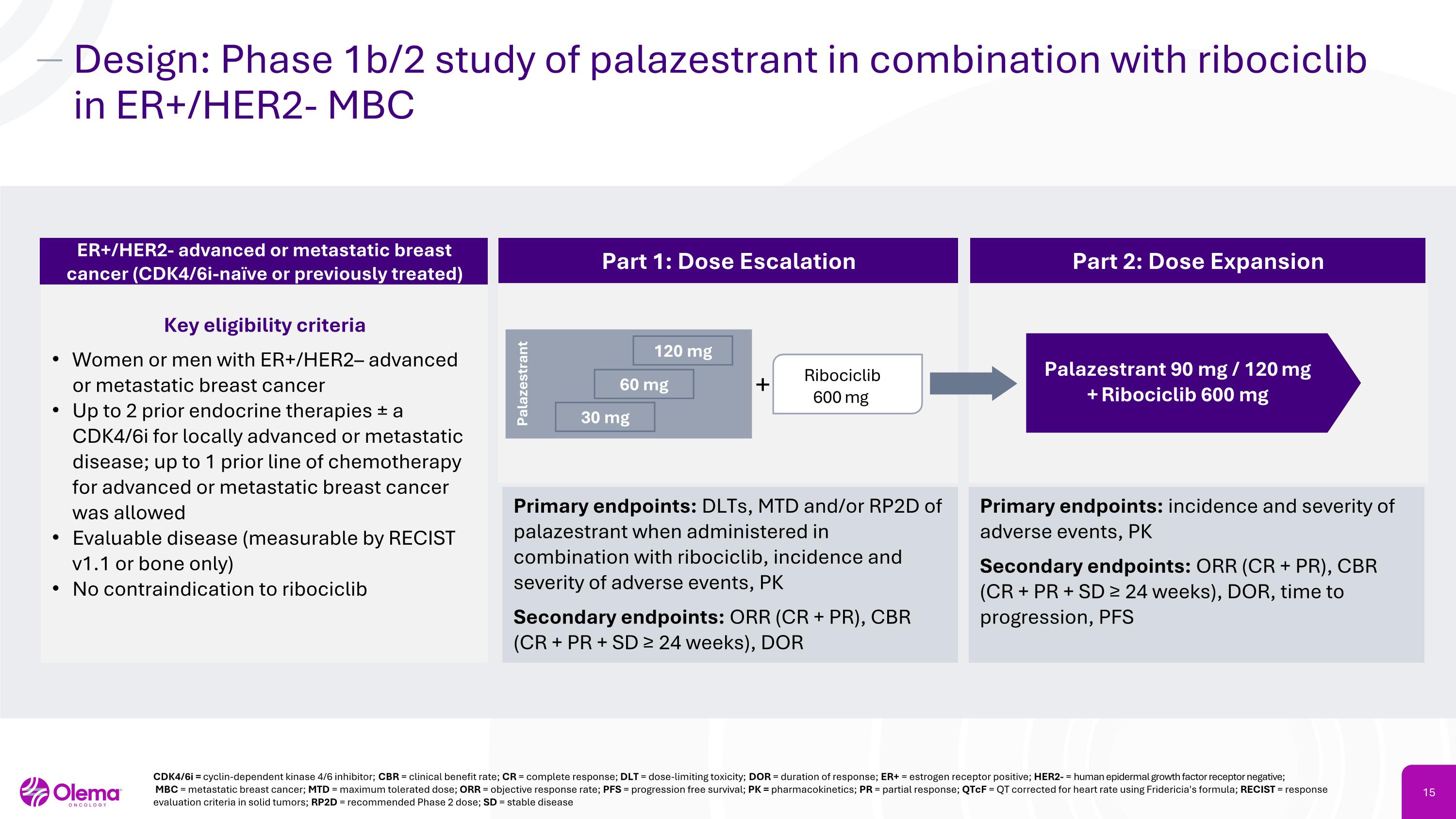
Design: Phase 1b/2 study of palazestrant in combination with ribociclib in ER+/HER2- MBC Key eligibility criteria Women or men with ER+/HER2– advanced or metastatic breast cancer Up to 2 prior endocrine therapies ± a CDK4/6i for locally advanced or metastatic disease; up to 1 prior line of chemotherapy for advanced or metastatic breast cancer was allowed Evaluable disease (measurable by RECIST v1.1 or bone only) No contraindication to ribociclib ER+/HER2- advanced or metastatic breast cancer (CDK4/6i-naïve or previously treated) Part 1: Dose Escalation Part 2: Dose Expansion Primary endpoints: DLTs, MTD and/or RP2D of palazestrant when administered in combination with ribociclib, incidence and severity of adverse events, PK Secondary endpoints: ORR (CR + PR), CBR (CR + PR + SD ≥ 24 weeks), DOR Primary endpoints: incidence and severity of adverse events, PK Secondary endpoints: ORR (CR + PR), CBR (CR + PR + SD ≥ 24 weeks), DOR, time to progression, PFS + Palazestrant 90 mg / 120 mg + Ribociclib 600 mg Ribociclib 600 mg Palazestrant 120 mg 60 mg 30 mg CDK4/6i = cyclin-dependent kinase 4/6 inhibitor; CBR = clinical benefit rate; CR = complete response; DLT = dose-limiting toxicity; DOR = duration of response; ER+ = estrogen receptor positive; HER2- = human epidermal growth factor receptor negative; MBC = metastatic breast cancer; MTD = maximum tolerated dose; ORR = objective response rate; PFS = progression free survival; PK = pharmacokinetics; PR = partial response; QTcF = QT corrected for heart rate using Fridericia's formula; RECIST = response evaluation criteria in solid tumors; RP2D = recommended Phase 2 dose; SD = stable disease
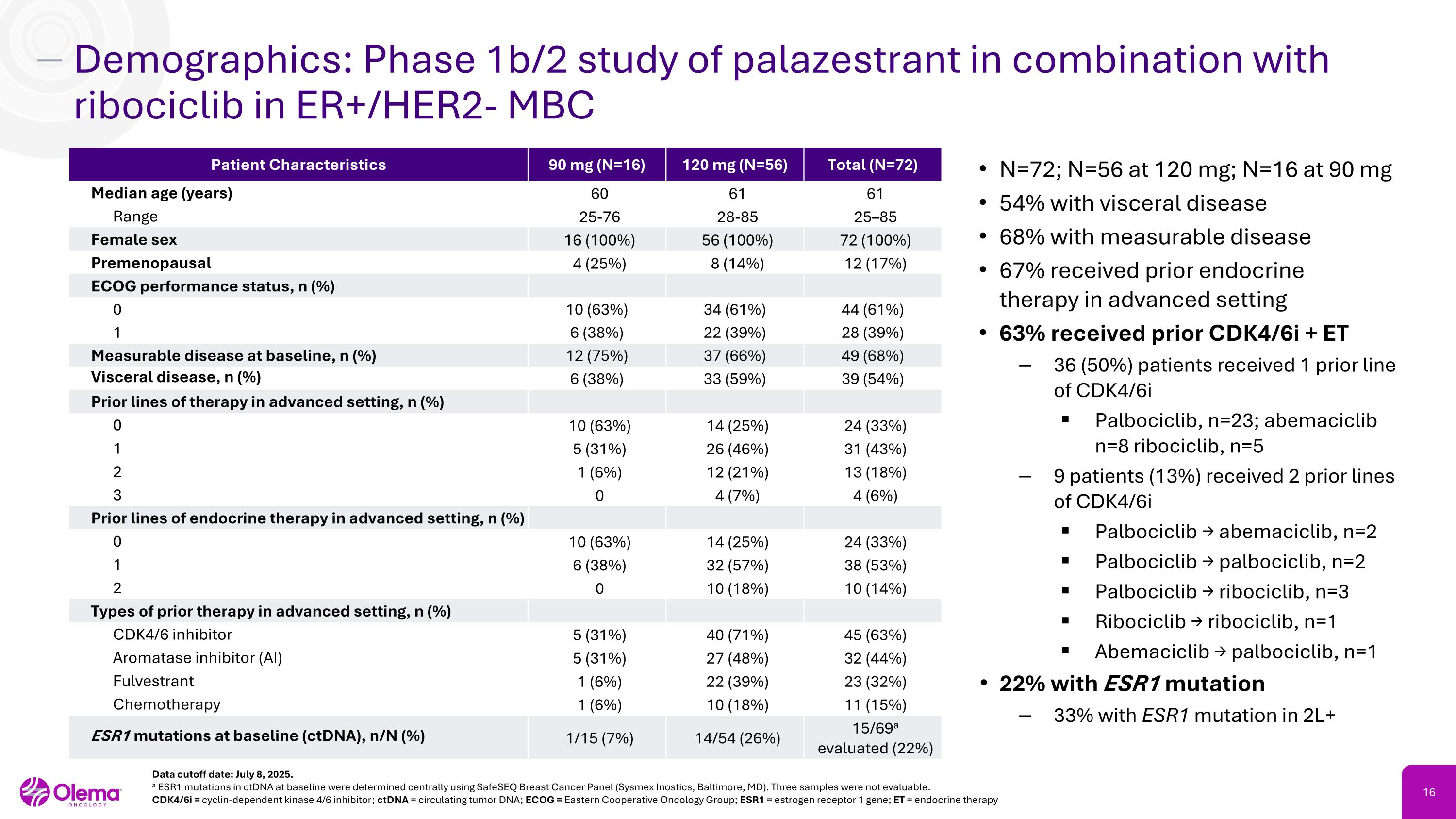
Demographics: Phase 1b/2 study of palazestrant in combination with ribociclib in ER+/HER2- MBC N=72; N=56 at 120 mg; N=16 at 90 mg 54% with visceral disease 68% with measurable disease 67% received prior endocrine therapy in advanced setting 63% received prior CDK4/6i + ET 36 (50%) patients received 1 prior line of CDK4/6i Palbociclib, n=23; abemaciclib n=8 ribociclib, n=5 9 patients (13%) received 2 prior lines of CDK4/6i Palbociclib → abemaciclib, n=2 Palbociclib → palbociclib, n=2 Palbociclib → ribociclib, n=3 Ribociclib → ribociclib, n=1 Abemaciclib → palbociclib, n=1 22% with ESR1 mutation 33% with ESR1 mutation in 2L+ Data cutoff date: July 8, 2025. a ESR1 mutations in ctDNA at baseline were determined centrally using SafeSEQ Breast Cancer Panel (Sysmex Inostics, Baltimore, MD). Three samples were not evaluable. CDK4/6i = cyclin-dependent kinase 4/6 inhibitor; ctDNA = circulating tumor DNA; ECOG = Eastern Cooperative Oncology Group; ESR1 = estrogen receptor 1 gene; ET = endocrine therapy Patient Characteristics 90 mg (N=16) 120 mg (N=56) Total (N=72) Median age (years) 60 61 61 Range 25-76 28-85 25–85 Female sex 16 (100%) 56 (100%) 72 (100%) Premenopausal 4 (25%) 8 (14%) 12 (17%) ECOG performance status, n (%) 0 10 (63%) 34 (61%) 44 (61%) 1 6 (38%) 22 (39%) 28 (39%) Measurable disease at baseline, n (%) 12 (75%) 37 (66%) 49 (68%) Visceral disease, n (%) 6 (38%) 33 (59%) 39 (54%) Prior lines of therapy in advanced setting, n (%) 0 10 (63%) 14 (25%) 24 (33%) 1 5 (31%) 26 (46%) 31 (43%) 2 1 (6%) 12 (21%) 13 (18%) 3 0 4 (7%) 4 (6%) Prior lines of endocrine therapy in advanced setting, n (%) 0 10 (63%) 14 (25%) 24 (33%) 1 6 (38%) 32 (57%) 38 (53%) 2 0 10 (18%) 10 (14%) Types of prior therapy in advanced setting, n (%) CDK4/6 inhibitor 5 (31%) 40 (71%) 45 (63%) Aromatase inhibitor (AI) 5 (31%) 27 (48%) 32 (44%) Fulvestrant 1 (6%) 22 (39%) 23 (32%) Chemotherapy 1 (6%) 10 (18%) 11 (15%) ESR1 mutations at baseline (ctDNA), n/N (%) 1/15 (7%) 14/54 (26%) 15/69a evaluated (22%)
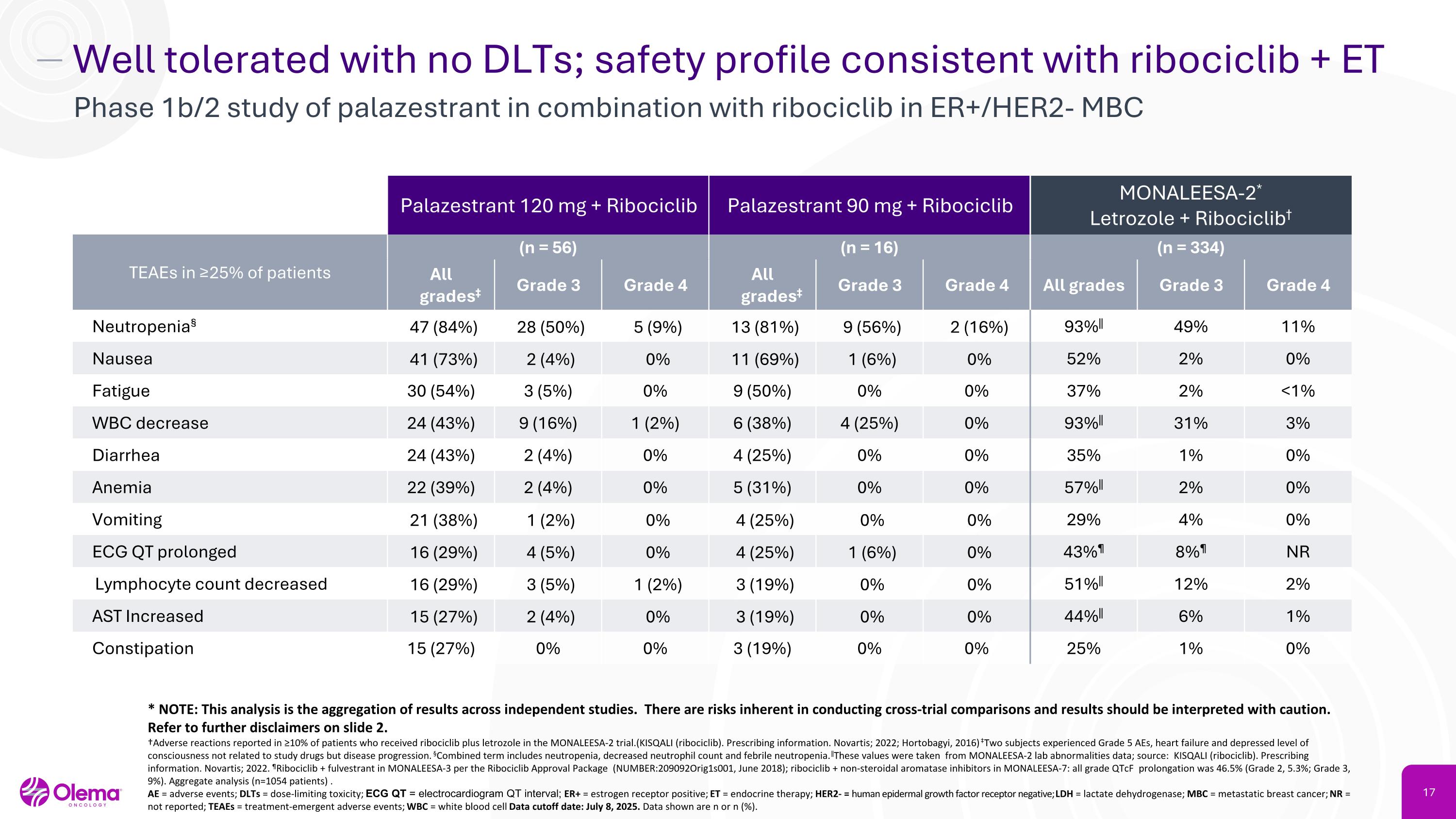
Well tolerated with no DLTs; safety profile consistent with ribociclib + ET Phase 1b/2 study of palazestrant in combination with ribociclib in ER+/HER2- MBC Palazestrant 120 mg + Ribociclib Palazestrant 90 mg + Ribociclib MONALEESA-2* Letrozole + Ribociclib† TEAEs in ≥25% of patients (n = 56) (n = 16) (n = 334) All grades‡ Grade 3 Grade 4 All grades‡ Grade 3 Grade 4 All grades Grade 3 Grade 4 Neutropenia§ 47 (84%) 28 (50%) 5 (9%) 13 (81%) 9 (56%) 2 (16%) 93%‖ 49% 11% Nausea 41 (73%) 2 (4%) 0% 11 (69%) 1 (6%) 0% 52% 2% 0% Fatigue 30 (54%) 3 (5%) 0% 9 (50%) 0% 0% 37% 2% <1% WBC decrease 24 (43%) 9 (16%) 1 (2%) 6 (38%) 4 (25%) 0% 93%‖ 31% 3% Diarrhea 24 (43%) 2 (4%) 0% 4 (25%) 0% 0% 35% 1% 0% Anemia 22 (39%) 2 (4%) 0% 5 (31%) 0% 0% 57%‖ 2% 0% Vomiting 21 (38%) 1 (2%) 0% 4 (25%) 0% 0% 29% 4% 0% ECG QT prolonged 16 (29%) 4 (5%) 0% 4 (25%) 1 (6%) 0% 43%¶ 8%¶ NR Lymphocyte count decreased 16 (29%) 3 (5%) 1 (2%) 3 (19%) 0% 0% 51%‖ 12% 2% AST Increased 15 (27%) 2 (4%) 0% 3 (19%) 0% 0% 44%‖ 6% 1% Constipation 15 (27%) 0% 0% 3 (19%) 0% 0% 25% 1% 0% * NOTE: This analysis is the aggregation of results across independent studies. There are risks inherent in conducting cross-trial comparisons and results should be interpreted with caution. Refer to further disclaimers on slide 2. †Adverse reactions reported in ≥10% of patients who received ribociclib plus letrozole in the MONALEESA-2 trial.(KISQALI (ribociclib). Prescribing information. Novartis; 2022; Hortobagyi, 2016) ‡Two subjects experienced Grade 5 AEs, heart failure and depressed level of consciousness not related to study drugs but disease progression. §Combined term includes neutropenia, decreased neutrophil count and febrile neutropenia. ‖These values were taken from MONALEESA-2 lab abnormalities data; source: KISQALI (ribociclib). Prescribing information. Novartis; 2022. ¶Ribociclib + fulvestrant in MONALEESA-3 per the Ribociclib Approval Package (NUMBER:209092Orig1s001, June 2018); ribociclib + non-steroidal aromatase inhibitors in MONALEESA-7: all grade QTcF prolongation was 46.5% (Grade 2, 5.3%; Grade 3, 9%). Aggregate analysis (n=1054 patients) . AE = adverse events; DLTs = dose-limiting toxicity; ECG QT = electrocardiogram QT interval; ER+ = estrogen receptor positive; ET = endocrine therapy; HER2- = human epidermal growth factor receptor negative; LDH = lactate dehydrogenase; MBC = metastatic breast cancer; NR = not reported; TEAEs = treatment-emergent adverse events; WBC = white blood cell Data cutoff date: July 8, 2025. Data shown are n or n (%).
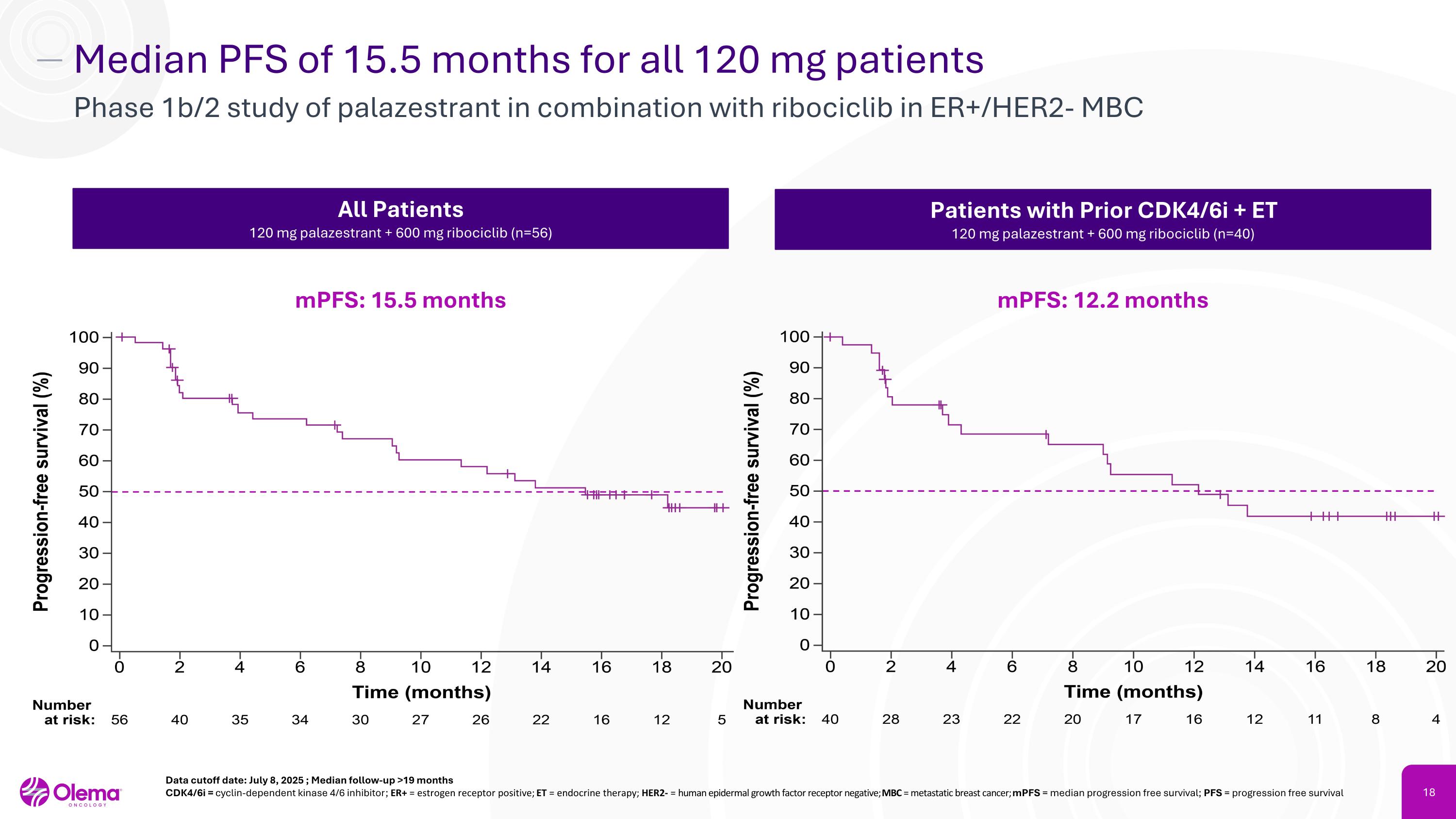
Data cutoff date: July 8, 2025 ; Median follow-up >19 months CDK4/6i = cyclin-dependent kinase 4/6 inhibitor; ER+ = estrogen receptor positive; ET = endocrine therapy; HER2- = human epidermal growth factor receptor negative; MBC = metastatic breast cancer; mPFS = median progression free survival; PFS = progression free survival Patients with Prior CDK4/6i + ET 120 mg palazestrant + 600 mg ribociclib (n=40) All Patients 120 mg palazestrant + 600 mg ribociclib (n=56) mPFS: 15.5 months mPFS: 12.2 months Median PFS of 15.5 months for all 120 mg patients Phase 1b/2 study of palazestrant in combination with ribociclib in ER+/HER2- MBC
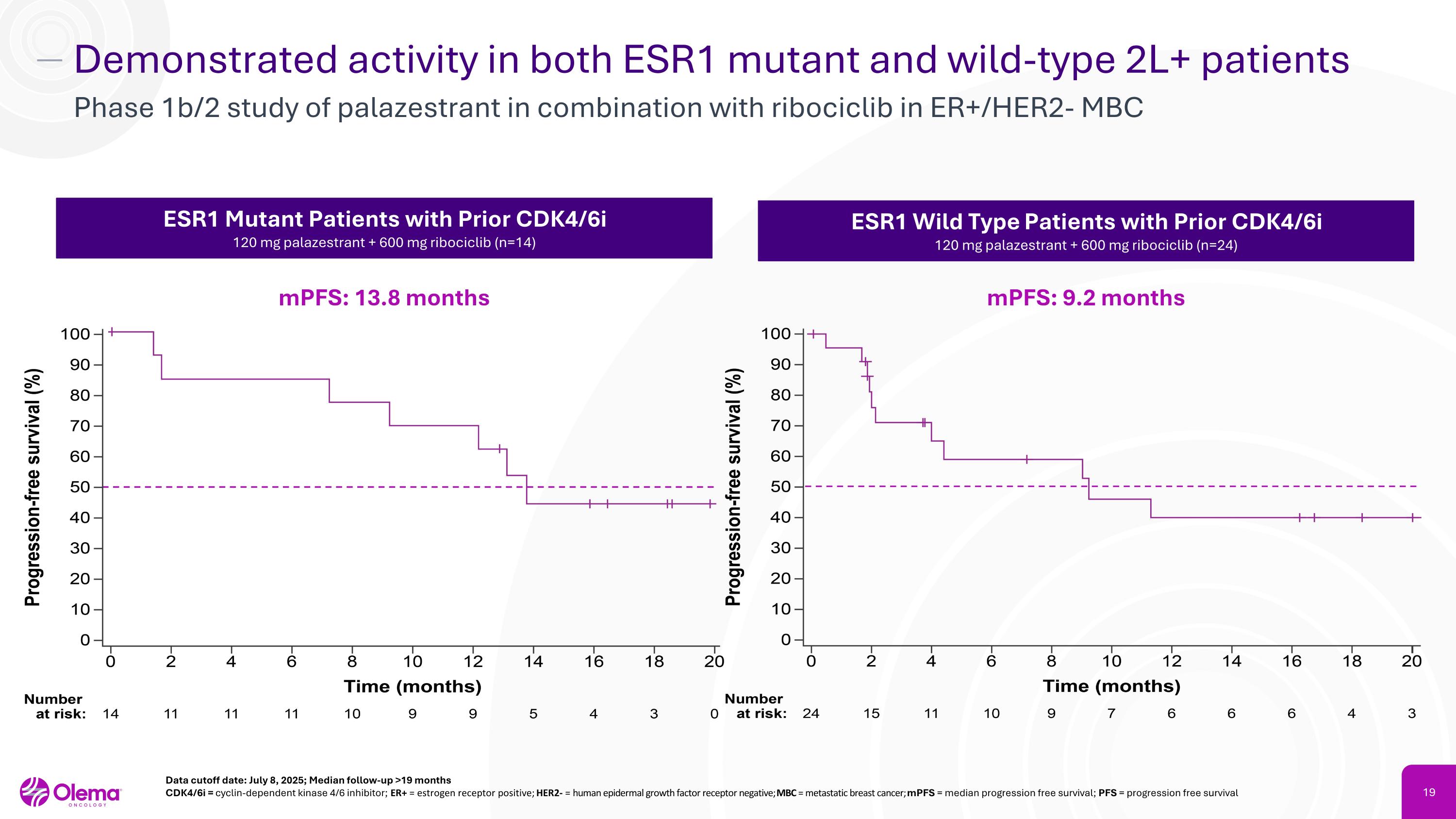
Demonstrated activity in both ESR1 mutant and wild-type 2L+ patients Phase 1b/2 study of palazestrant in combination with ribociclib in ER+/HER2- MBC Data cutoff date: July 8, 2025; Median follow-up >19 months CDK4/6i = cyclin-dependent kinase 4/6 inhibitor; ER+ = estrogen receptor positive; HER2- = human epidermal growth factor receptor negative; MBC = metastatic breast cancer; mPFS = median progression free survival; PFS = progression free survival ESR1 Mutant Patients with Prior CDK4/6i 120 mg palazestrant + 600 mg ribociclib (n=14) ESR1 Wild Type Patients with Prior CDK4/6i 120 mg palazestrant + 600 mg ribociclib (n=24) mPFS: 9.2 months mPFS: 13.8 months
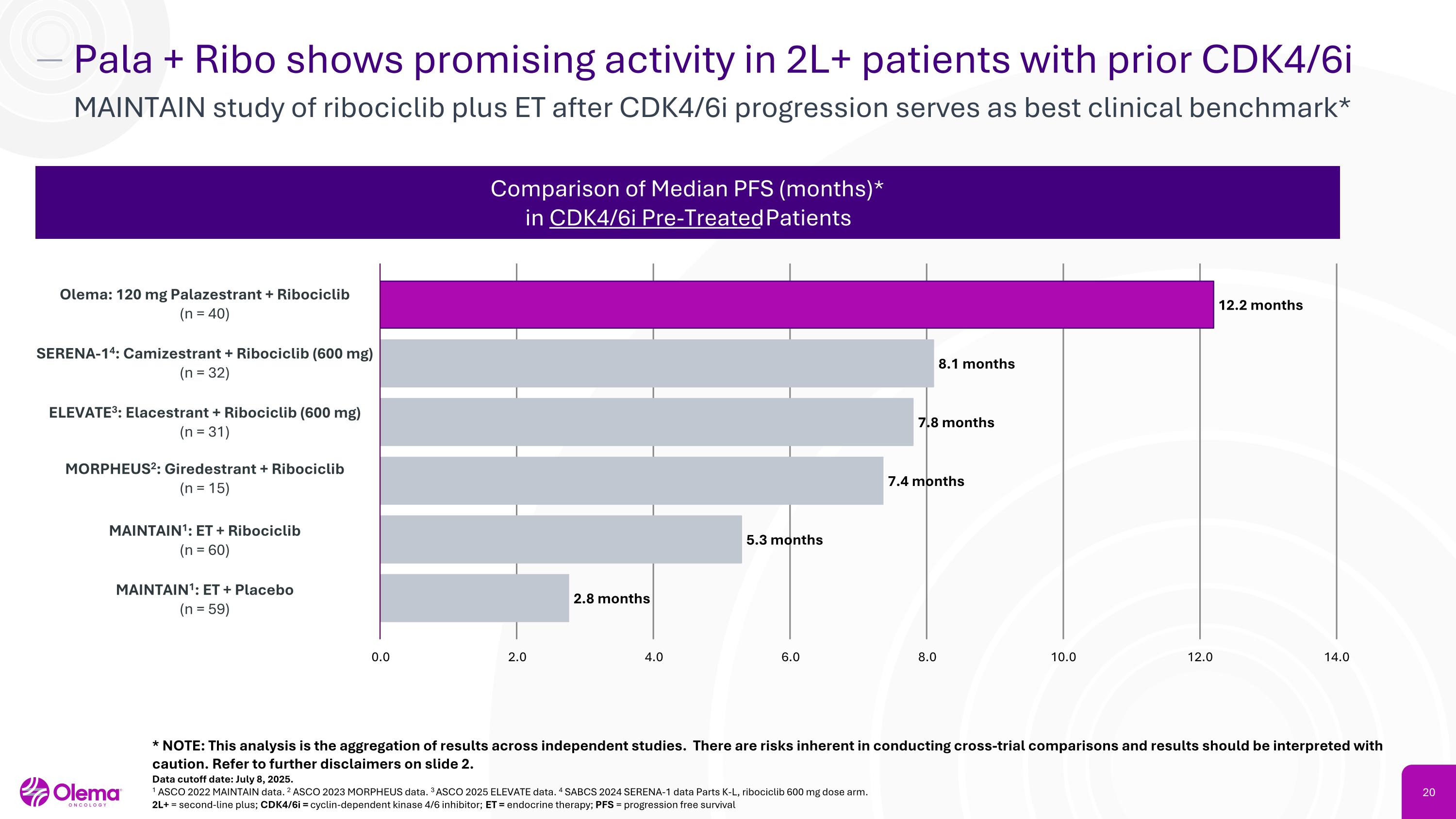
Pala + Ribo shows promising activity in 2L+ patients with prior CDK4/6i MAINTAIN study of ribociclib plus ET after CDK4/6i progression serves as best clinical benchmark* * NOTE: This analysis is the aggregation of results across independent studies. There are risks inherent in conducting cross-trial comparisons and results should be interpreted with caution. Refer to further disclaimers on slide 2. Data cutoff date: July 8, 2025. 1 ASCO 2022 MAINTAIN data. 2 ASCO 2023 MORPHEUS data. 3 ASCO 2025 ELEVATE data. 4 SABCS 2024 SERENA-1 data Parts K-L, ribociclib 600 mg dose arm. 2L+ = second-line plus; CDK4/6i = cyclin-dependent kinase 4/6 inhibitor; ET = endocrine therapy; PFS = progression free survival Comparison of Median PFS (months)* in CDK4/6i Pre-Treated Patients MAINTAIN1: ET + Placebo (n = 59) Olema: 120 mg Palazestrant + Ribociclib (n = 40) MORPHEUS2: Giredestrant + Ribociclib (n = 15) MAINTAIN1: ET + Ribociclib (n = 60) SERENA-14: Camizestrant + Ribociclib (600 mg) (n = 32) ELEVATE3: Elacestrant + Ribociclib (600 mg) (n = 31)
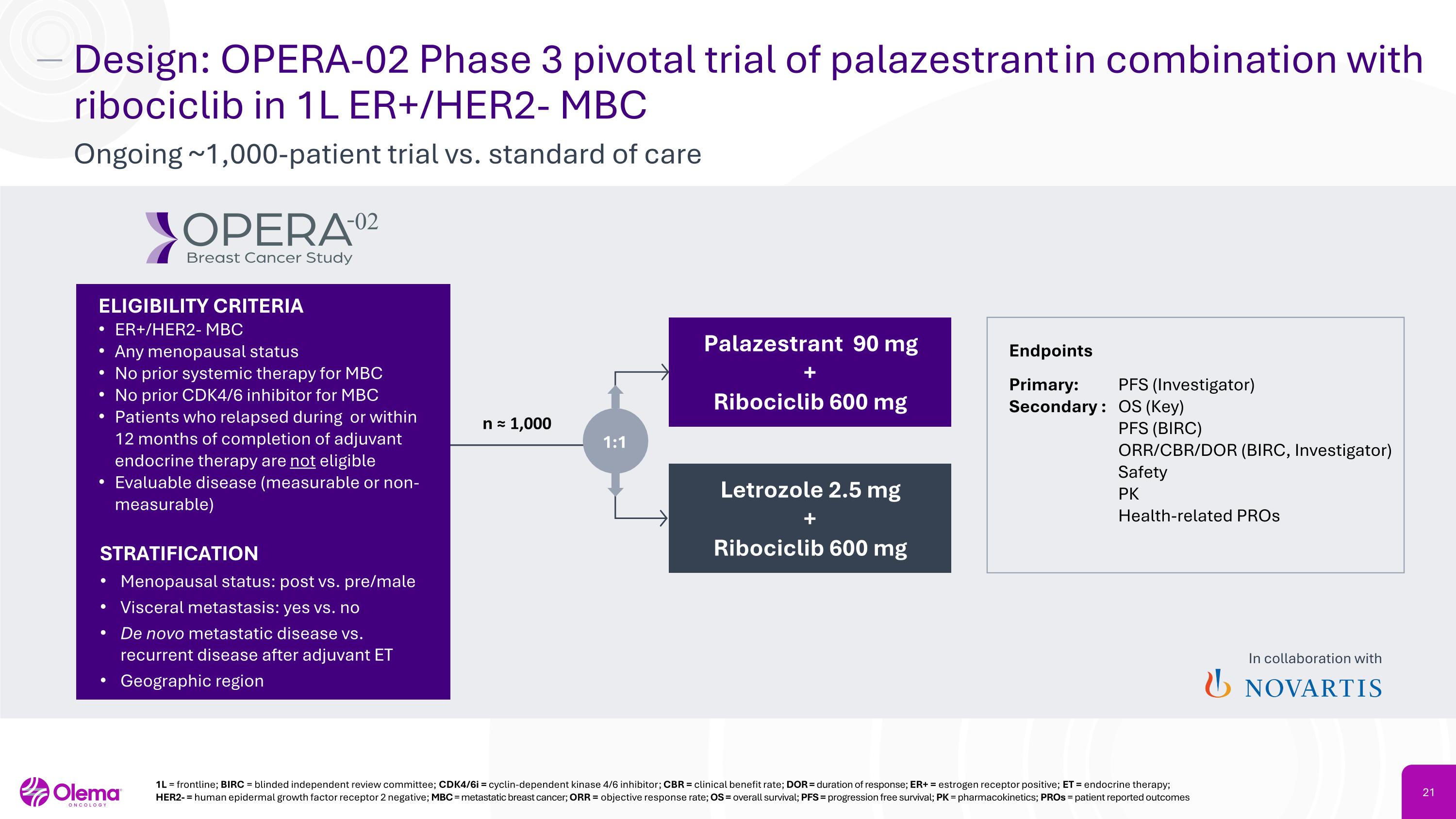
Design: OPERA-02 Phase 3 pivotal trial of palazestrant in combination with ribociclib in 1L ER+/HER2- MBC Ongoing ~1,000-patient trial vs. standard of care Endpoints Primary: PFS (Investigator) Secondary : OS (Key) PFS (BIRC) ORR/CBR/DOR (BIRC, Investigator) Safety PK Health-related PROs n ≈ 1,000 Palazestrant 90 mg + Ribociclib 600 mg Letrozole 2.5 mg + Ribociclib 600 mg 1:1 In collaboration with 1L = frontline; BIRC = blinded independent review committee; CDK4/6i = cyclin-dependent kinase 4/6 inhibitor; CBR = clinical benefit rate; DOR = duration of response; ER+ = estrogen receptor positive; ET = endocrine therapy; HER2- = human epidermal growth factor receptor 2 negative; MBC = metastatic breast cancer; ORR = objective response rate; OS = overall survival; PFS = progression free survival; PK = pharmacokinetics; PROs = patient reported outcomes ELIGIBILITY CRITERIA ER+/HER2- MBC Any menopausal status No prior systemic therapy for MBC No prior CDK4/6 inhibitor for MBC Patients who relapsed during or within 12 months of completion of adjuvant endocrine therapy are not eligible Evaluable disease (measurable or non-measurable) STRATIFICATION Menopausal status: post vs. pre/male Visceral metastasis: yes vs. no De novo metastatic disease vs. recurrent disease after adjuvant ET Geographic region
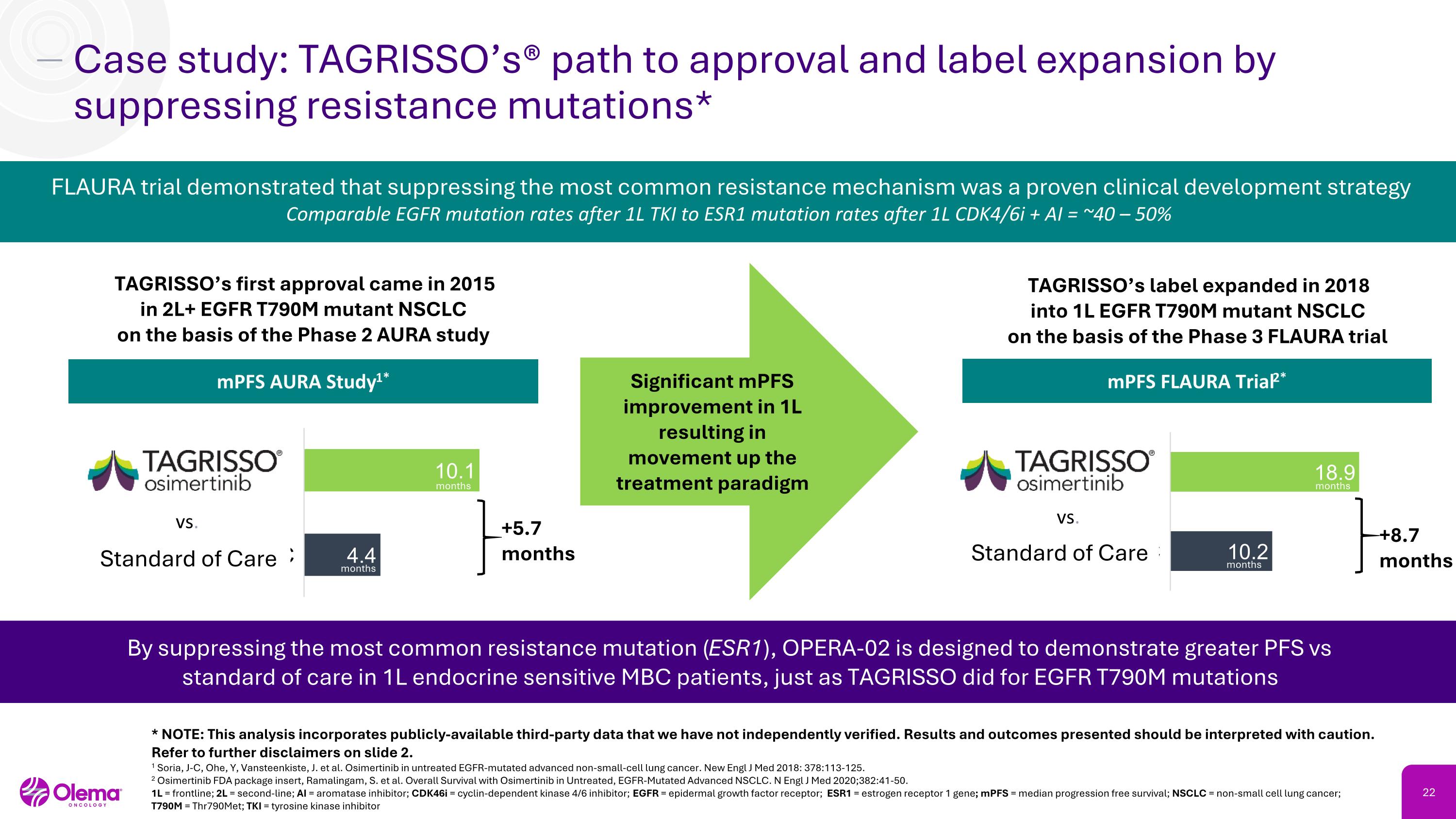
Case study: TAGRISSO’s® path to approval and label expansion by suppressing resistance mutations* * NOTE: This analysis incorporates publicly-available third-party data that we have not independently verified. Results and outcomes presented should be interpreted with caution. Refer to further disclaimers on slide 2. 1 Soria, J-C, Ohe, Y, Vansteenkiste, J. et al. Osimertinib in untreated EGFR-mutated advanced non-small-cell lung cancer. New Engl J Med 2018: 378:113-125. 2 Osimertinib FDA package insert, Ramalingam, S. et al. Overall Survival with Osimertinib in Untreated, EGFR-Mutated Advanced NSCLC. N Engl J Med 2020;382:41-50. 1L = frontline; 2L = second-line; AI = aromatase inhibitor; CDK46i = cyclin-dependent kinase 4/6 inhibitor; EGFR = epidermal growth factor receptor; ESR1 = estrogen receptor 1 gene; mPFS = median progression free survival; NSCLC = non-small cell lung cancer; T790M = Thr790Met; TKI = tyrosine kinase inhibitor FLAURA trial demonstrated that suppressing the most common resistance mechanism was a proven clinical development strategy Comparable EGFR mutation rates after 1L TKI to ESR1 mutation rates after 1L CDK4/6i + AI = ~40 – 50% TAGRISSO’s first approval came in 2015 in 2L+ EGFR T790M mutant NSCLC on the basis of the Phase 2 AURA study TAGRISSO’s label expanded in 2018 into 1L EGFR T790M mutant NSCLC on the basis of the Phase 3 FLAURA trial By suppressing the most common resistance mutation (ESR1), OPERA-02 is designed to demonstrate greater PFS vs standard of care in 1L endocrine sensitive MBC patients, just as TAGRISSO did for EGFR T790M mutations mPFS AURA Study1* vs. Significant mPFS improvement in 1L resulting in movement up the treatment paradigm mPFS FLAURA Trial2* +8.7 months +5.7 months Standard of Care vs. Standard of Care months months months months
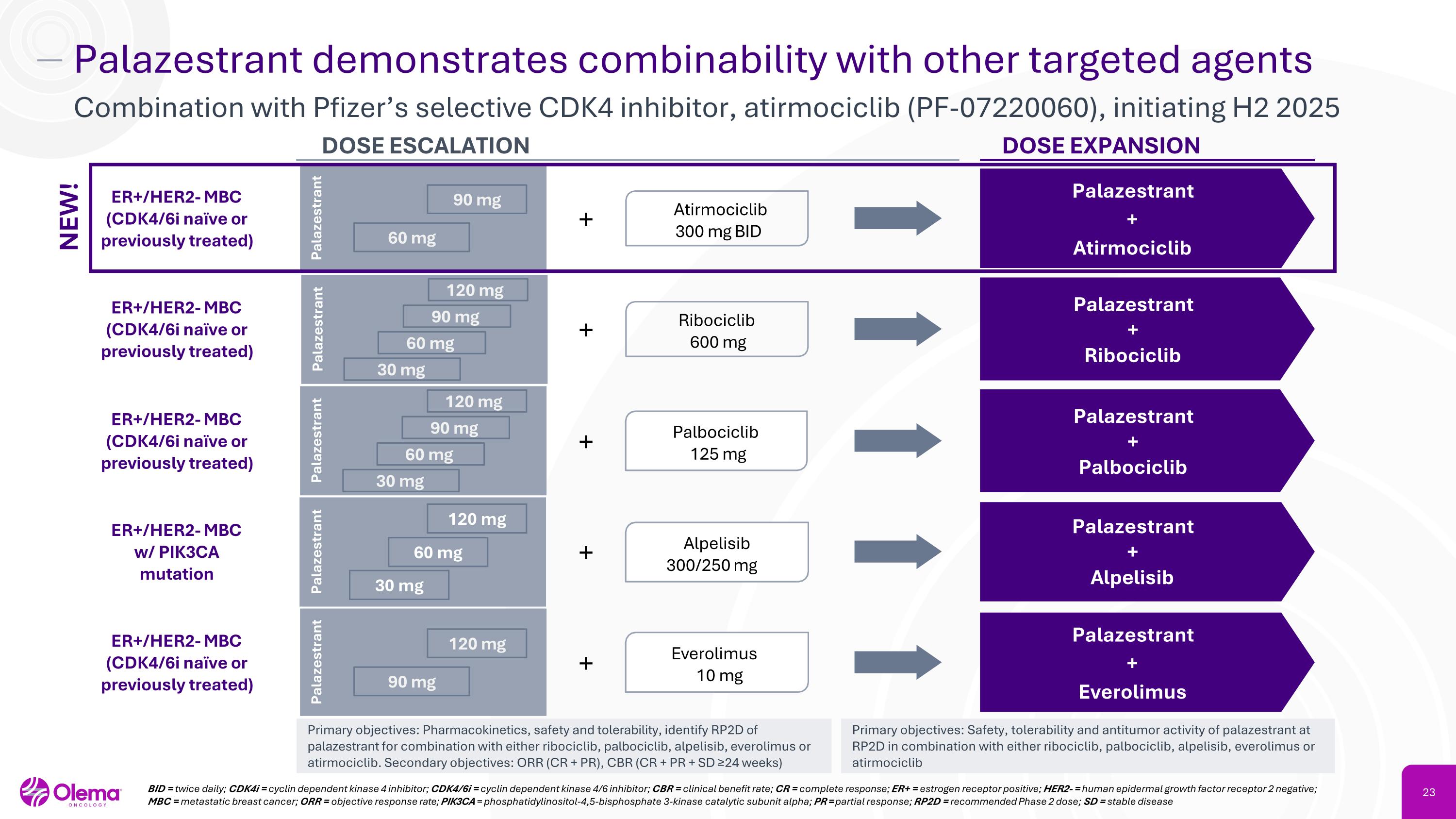
Palazestrant demonstrates combinability with other targeted agents Combination with Pfizer’s selective CDK4 inhibitor, atirmociclib (PF-07220060), initiating H2 2025 BID = twice daily; CDK4i = cyclin dependent kinase 4 inhibitor; CDK4/6i = cyclin dependent kinase 4/6 inhibitor; CBR = clinical benefit rate; CR = complete response; ER+ = estrogen receptor positive; HER2- = human epidermal growth factor receptor 2 negative; MBC = metastatic breast cancer; ORR = objective response rate; PIK3CA = phosphatidylinositol-4,5-bisphosphate 3-kinase catalytic subunit alpha; PR = partial response; RP2D = recommended Phase 2 dose; SD = stable disease DOSE EXPANSION DOSE ESCALATION Primary objectives: Pharmacokinetics, safety and tolerability, identify RP2D of palazestrant for combination with either ribociclib, palbociclib, alpelisib, everolimus or atirmociclib. Secondary objectives: ORR (CR + PR), CBR (CR + PR + SD ≥24 weeks) Primary objectives: Safety, tolerability and antitumor activity of palazestrant at RP2D in combination with either ribociclib, palbociclib, alpelisib, everolimus or atirmociclib Atirmociclib 300 mg BID ER+/HER2- MBC (CDK4/6i naïve or previously treated) 60 mg 90 mg + Palazestrant Palazestrant + Atirmociclib + ER+/HER2- MBC (CDK4/6i naïve or previously treated) Palazestrant + Palbociclib Palbociclib 125 mg 30 mg 60 mg 120 mg 90 mg Palazestrant ER+/HER2- MBC (CDK4/6i naïve or previously treated) 90 mg 120 mg + Everolimus 10 mg Palazestrant Palazestrant + Everolimus + ER+/HER2- MBC w/ PIK3CA mutation Palazestrant + Alpelisib Alpelisib 300/250 mg Palazestrant 120 mg 60 mg 30 mg + ER+/HER2- MBC (CDK4/6i naïve or previously treated) Palazestrant + Ribociclib Ribociclib 600 mg Palazestrant 30 mg 60 mg 120 mg 90 mg Palazestrant NEW!
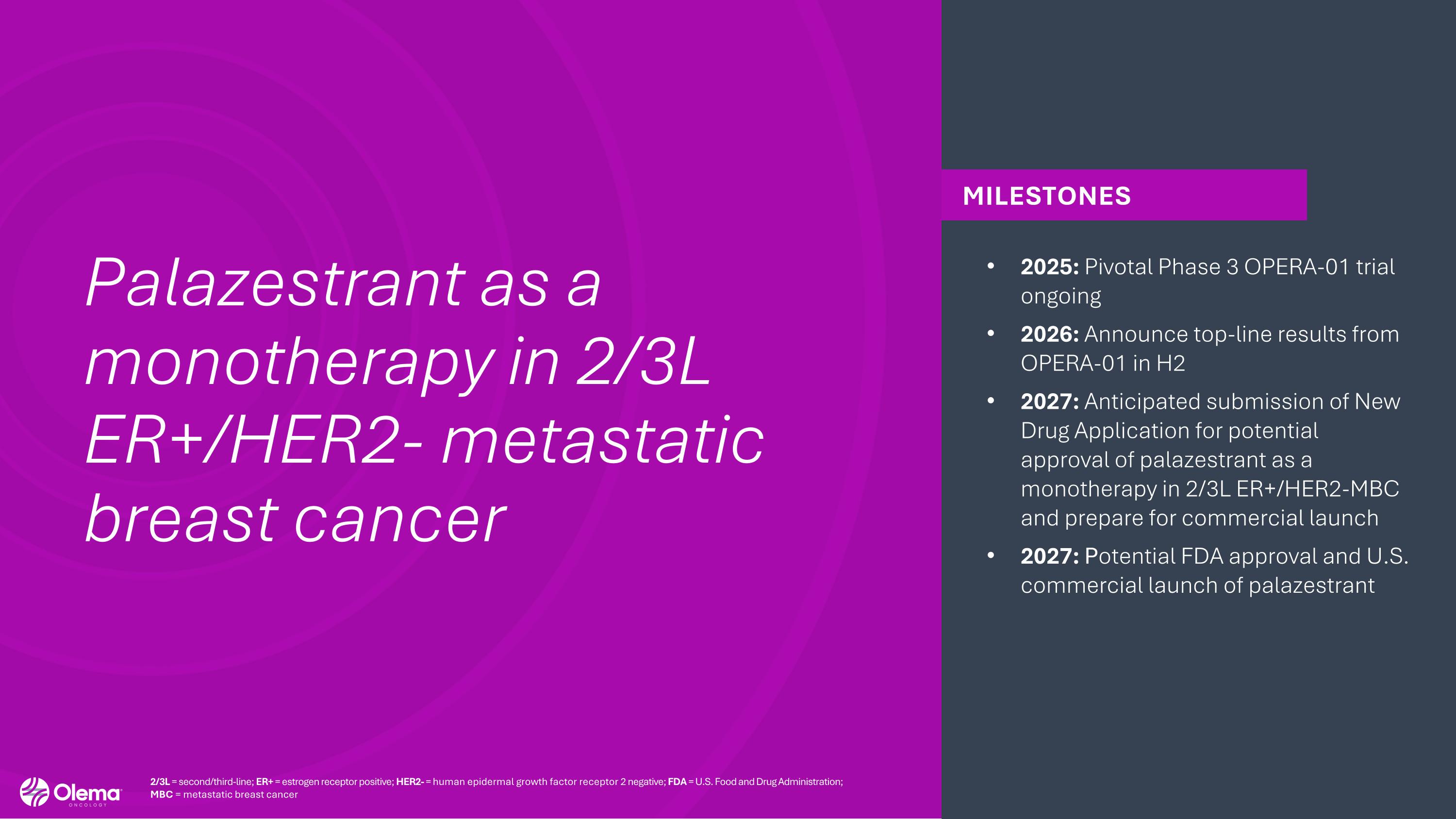
Palazestrant as a monotherapy in 2/3L ER+/HER2- metastatic breast cancer MILESTONES 2025: Pivotal Phase 3 OPERA-01 trial ongoing 2026: Announce top-line results from OPERA-01 in H2 2027: Anticipated submission of New Drug Application for potential approval of palazestrant as a monotherapy in 2/3L ER+/HER2-MBC and prepare for commercial launch 2027: Potential FDA approval and U.S. commercial launch of palazestrant 2/3L = second/third-line; ER+ = estrogen receptor positive; HER2- = human epidermal growth factor receptor 2 negative; FDA = U.S. Food and Drug Administration; MBC = metastatic breast cancer
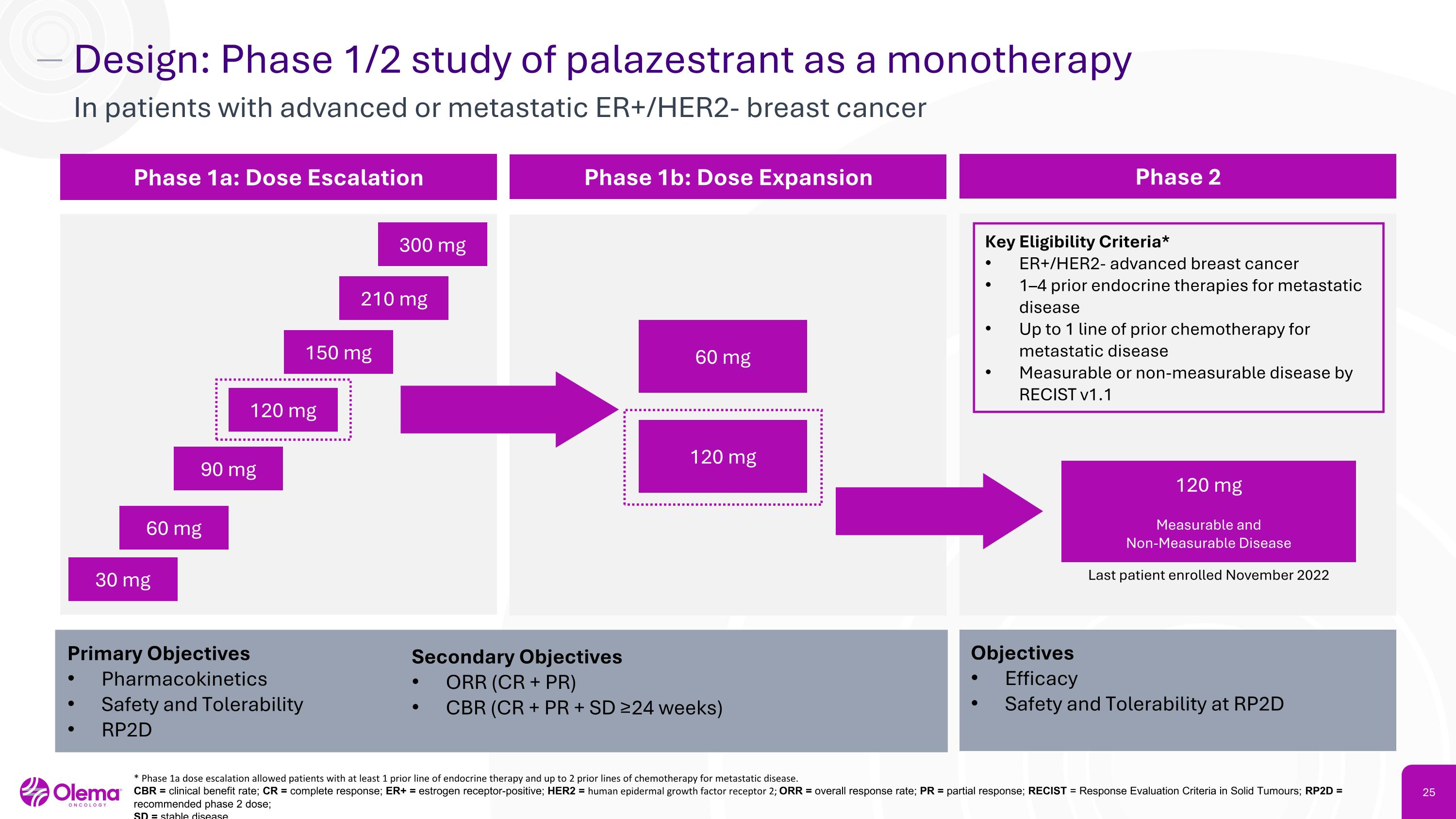
Design: Phase 1/2 study of palazestrant as a monotherapy In patients with advanced or metastatic ER+/HER2- breast cancer Primary Objectives Pharmacokinetics Safety and Tolerability RP2D Phase 1a: Dose Escalation Phase 1b: Dose Expansion Phase 2 Objectives Efficacy Safety and Tolerability at RP2D * Phase 1a dose escalation allowed patients with at least 1 prior line of endocrine therapy and up to 2 prior lines of chemotherapy for metastatic disease. CBR = clinical benefit rate; CR = complete response; ER+ = estrogen receptor-positive; HER2 = human epidermal growth factor receptor 2; ORR = overall response rate; PR = partial response; RECIST = Response Evaluation Criteria in Solid Tumours; RP2D = recommended phase 2 dose; SD = stable disease Key Eligibility Criteria* ER+/HER2- advanced breast cancer 1–4 prior endocrine therapies for metastatic disease Up to 1 line of prior chemotherapy for metastatic disease Measurable or non-measurable disease by RECIST v1.1 30 mg 300 mg 120 mg 90 mg 60 mg 150 mg 210 mg 60 mg 120 mg 120 mg Measurable and Non-Measurable Disease Last patient enrolled November 2022 Secondary Objectives ORR (CR + PR) CBR (CR + PR + SD ≥24 weeks)
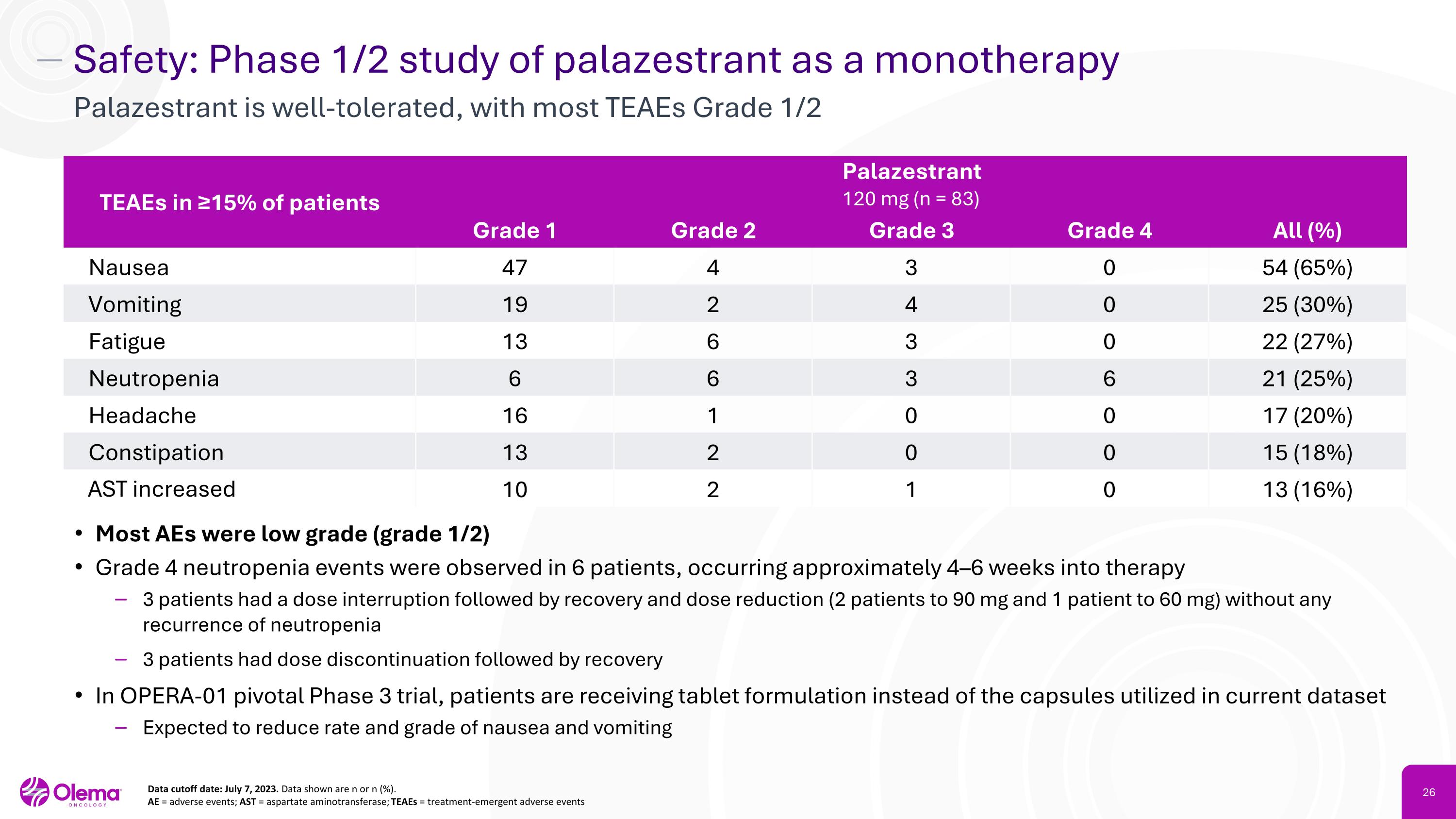
Safety: Phase 1/2 study of palazestrant as a monotherapy Palazestrant is well-tolerated, with most TEAEs Grade 1/2 TEAEs in ≥15% of patients Palazestrant 120 mg (n = 83) Grade 1 Grade 2 Grade 3 Grade 4 All (%) Nausea 47 4 3 0 54 (65%) Vomiting 19 2 4 0 25 (30%) Fatigue 13 6 3 0 22 (27%) Neutropenia 6 6 3 6 21 (25%) Headache 16 1 0 0 17 (20%) Constipation 13 2 0 0 15 (18%) AST increased 10 2 1 0 13 (16%) Data cutoff date: July 7, 2023. Data shown are n or n (%). AE = adverse events; AST = aspartate aminotransferase; TEAEs = treatment-emergent adverse events Most AEs were low grade (grade 1/2) Grade 4 neutropenia events were observed in 6 patients, occurring approximately 4–6 weeks into therapy 3 patients had a dose interruption followed by recovery and dose reduction (2 patients to 90 mg and 1 patient to 60 mg) without any recurrence of neutropenia 3 patients had dose discontinuation followed by recovery In OPERA-01 pivotal Phase 3 trial, patients are receiving tablet formulation instead of the capsules utilized in current dataset Expected to reduce rate and grade of nausea and vomiting
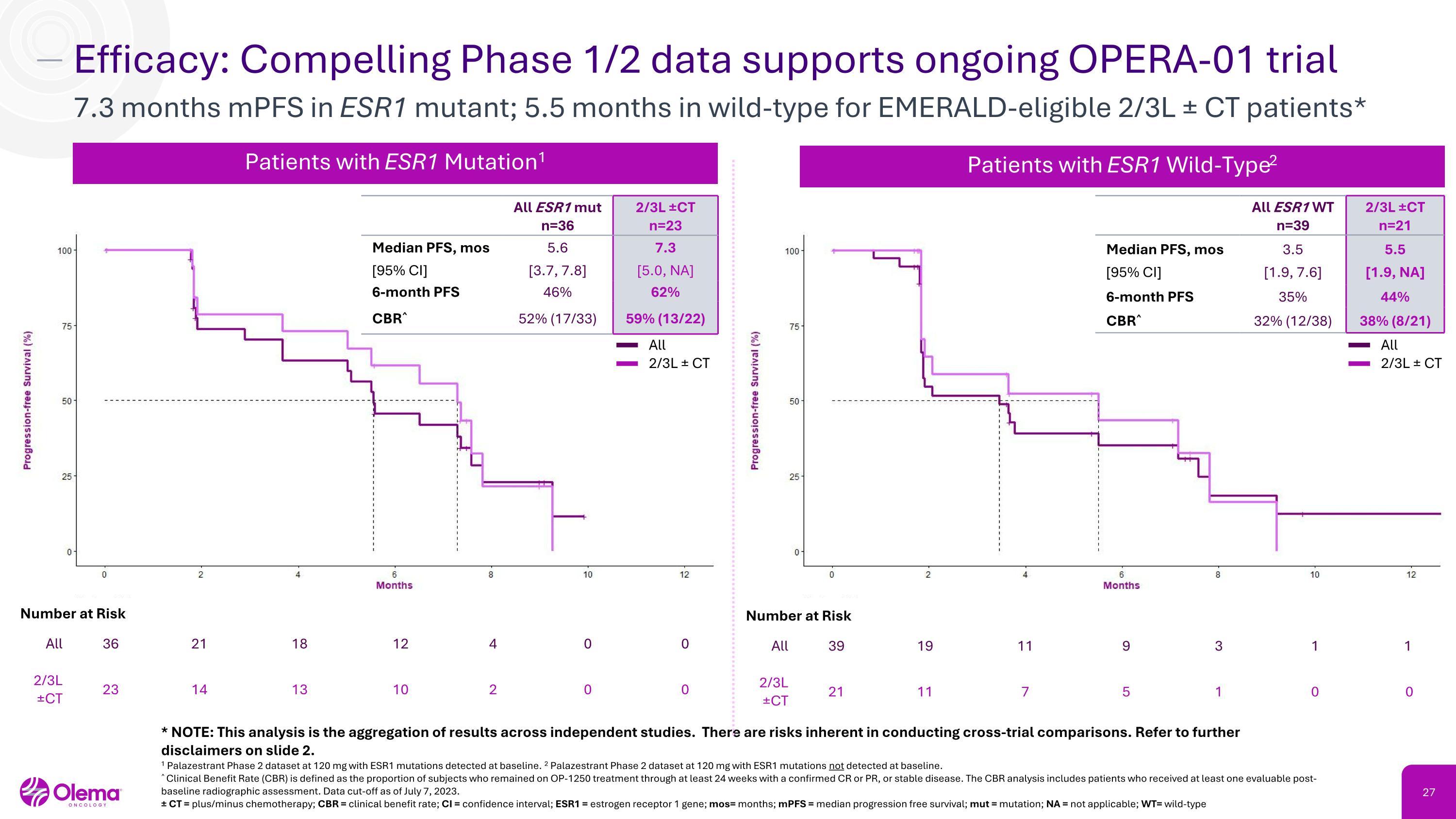
All 36 21 18 12 4 0 0 2/3L ±CT 23 14 13 10 2 0 0 Efficacy: Compelling Phase 1/2 data supports ongoing OPERA-01 trial 7.3 months mPFS in ESR1 mutant; 5.5 months in wild-type for EMERALD-eligible 2/3L ± CT patients* * NOTE: This analysis is the aggregation of results across independent studies. There are risks inherent in conducting cross-trial comparisons. Refer to further disclaimers on slide 2. 1 Palazestrant Phase 2 dataset at 120 mg with ESR1 mutations detected at baseline. 2 Palazestrant Phase 2 dataset at 120 mg with ESR1 mutations not detected at baseline. ^ Clinical Benefit Rate (CBR) is defined as the proportion of subjects who remained on OP-1250 treatment through at least 24 weeks with a confirmed CR or PR, or stable disease. The CBR analysis includes patients who received at least one evaluable post-baseline radiographic assessment. Data cut-off as of July 7, 2023. ± CT = plus/minus chemotherapy; CBR = clinical benefit rate; CI = confidence interval; ESR1 = estrogen receptor 1 gene; mos= months; mPFS = median progression free survival; mut = mutation; NA = not applicable; WT= wild-type Patients with ESR1 Mutation1 All ESR1 mut n=36 2/3L ±CT n=23 Median PFS, mos [95% CI] 5.6 [3.7, 7.8] 7.3 [5.0, NA] 6-month PFS 46% 62% CBR^ 52% (17/33) 59% (13/22) Patients with ESR1 Wild-Type2 All ESR1 WT n=39 2/3L ±CT n=21 Median PFS, mos [95% CI] 3.5 [1.9, 7.6] 5.5 [1.9, NA] 6-month PFS 35% 44% CBR^ 32% (12/38) 38% (8/21) Number at Risk All 39 19 11 9 3 1 1 2/3L ±CT 21 11 7 5 1 0 0 Number at Risk All 2/3L ± CT All 2/3L ± CT
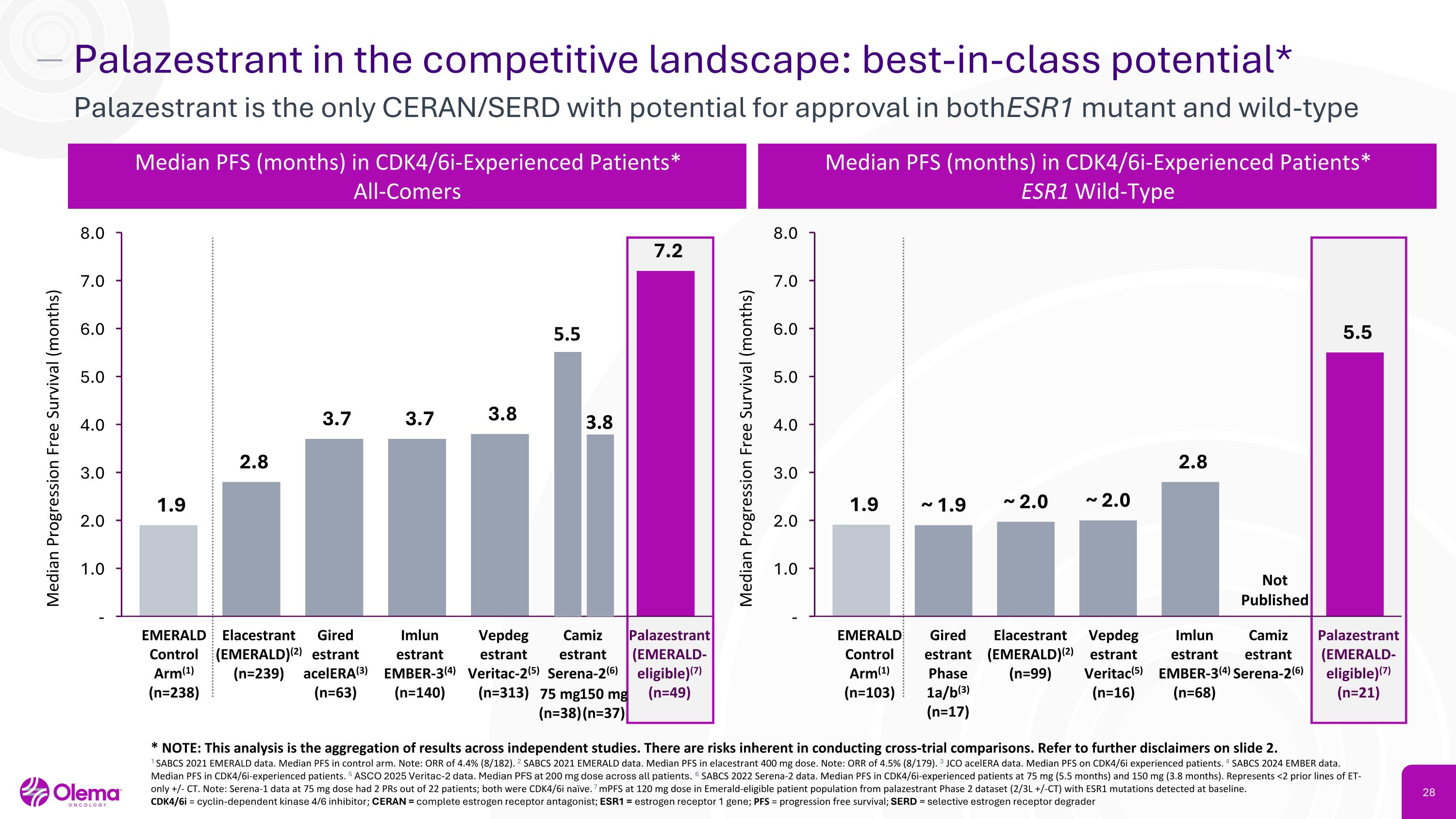
Palazestrant in the competitive landscape: best-in-class potential* Palazestrant is the only CERAN/SERD with potential for approval in both ESR1 mutant and wild-type Median Progression Free Survival (months) EMERALD Control Arm(1) (n=103) Gired estrant Phase 1a/b(3) (n=17) Elacestrant (EMERALD)(2) (n=99) Vepdeg estrant Veritac(5) (n=16) Imlun estrant EMBER-3(4) (n=68) Camiz estrant Serena-2(6) Not Published Median Progression Free Survival (months) EMERALD Control Arm(1) (n=238) Elacestrant (EMERALD)(2) (n=239) Palazestrant (EMERALD-eligible)(7) (n=49) 150 mg (n=37) Vepdeg estrant Veritac-2(5) (n=313) Median PFS (months) in CDK4/6i-Experienced Patients* All-Comers 3.8 5.5 75 mg (n=38) Gired estrant acelERA(3) (n=63) Imlun estrant EMBER-3(4) (n=140) Camiz estrant Serena-2(6) Median PFS (months) in CDK4/6i-Experienced Patients* ESR1 Wild-Type Palazestrant (EMERALD-eligible)(7) (n=21) * NOTE: This analysis is the aggregation of results across independent studies. There are risks inherent in conducting cross-trial comparisons. Refer to further disclaimers on slide 2. 1 SABCS 2021 EMERALD data. Median PFS in control arm. Note: ORR of 4.4% (8/182). 2 SABCS 2021 EMERALD data. Median PFS in elacestrant 400 mg dose. Note: ORR of 4.5% (8/179). 3 JCO acelERA data. Median PFS on CDK4/6i experienced patients. 4 SABCS 2024 EMBER data. Median PFS in CDK4/6i-experienced patients. 5 ASCO 2025 Veritac-2 data. Median PFS at 200 mg dose across all patients. 6 SABCS 2022 Serena-2 data. Median PFS in CDK4/6i-experienced patients at 75 mg (5.5 months) and 150 mg (3.8 months). Represents <2 prior lines of ET-only +/- CT. Note: Serena-1 data at 75 mg dose had 2 PRs out of 22 patients; both were CDK4/6i naïve. 7 mPFS at 120 mg dose in Emerald-eligible patient population from palazestrant Phase 2 dataset (2/3L +/-CT) with ESR1 mutations detected at baseline. CDK4/6i = cyclin-dependent kinase 4/6 inhibitor; CERAN = complete estrogen receptor antagonist; ESR1 = estrogen receptor 1 gene; PFS = progression free survival; SERD = selective estrogen receptor degrader
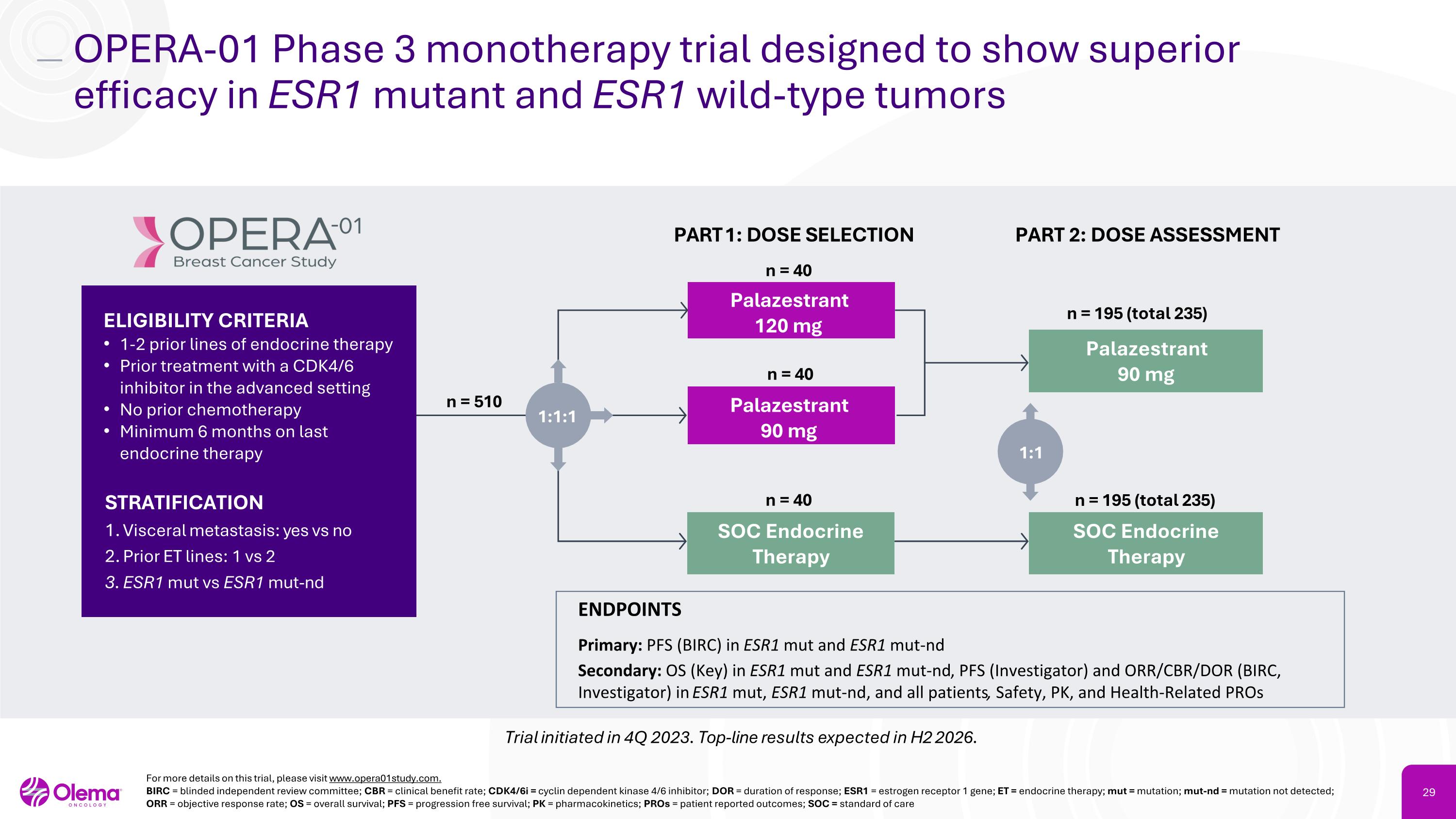
OPERA-01 Phase 3 monotherapy trial designed to show superior efficacy in ESR1 mutant and ESR1 wild-type tumors For more details on this trial, please visit www.opera01study.com. BIRC = blinded independent review committee; CBR = clinical benefit rate; CDK4/6i = cyclin dependent kinase 4/6 inhibitor; DOR = duration of response; ESR1 = estrogen receptor 1 gene; ET = endocrine therapy; mut = mutation; mut-nd = mutation not detected; ORR = objective response rate; OS = overall survival; PFS = progression free survival; PK = pharmacokinetics; PROs = patient reported outcomes; SOC = standard of care Trial initiated in 4Q 2023. Top-line results expected in H2 2026. Palazestrant 120 mg Palazestrant 90 mg n = 510 n = 40 PART 1: DOSE SELECTION n = 40 n = 195 (total 235) n = 195 (total 235) PART 2: DOSE ASSESSMENT 1:1:1 ELIGIBILITY CRITERIA 1-2 prior lines of endocrine therapy Prior treatment with a CDK4/6 inhibitor in the advanced setting No prior chemotherapy Minimum 6 months on last endocrine therapy STRATIFICATION Visceral metastasis: yes vs no Prior ET lines: 1 vs 2 ESR1 mut vs ESR1 mut-nd SOC Endocrine Therapy SOC Endocrine Therapy 1:1 ENDPOINTS Primary: PFS (BIRC) in ESR1 mut and ESR1 mut-nd Secondary: OS (Key) in ESR1 mut and ESR1 mut-nd, PFS (Investigator) and ORR/CBR/DOR (BIRC, Investigator) in ESR1 mut, ESR1 mut-nd, and all patients, Safety, PK, and Health-Related PROs n = 40 Palazestrant 90 mg
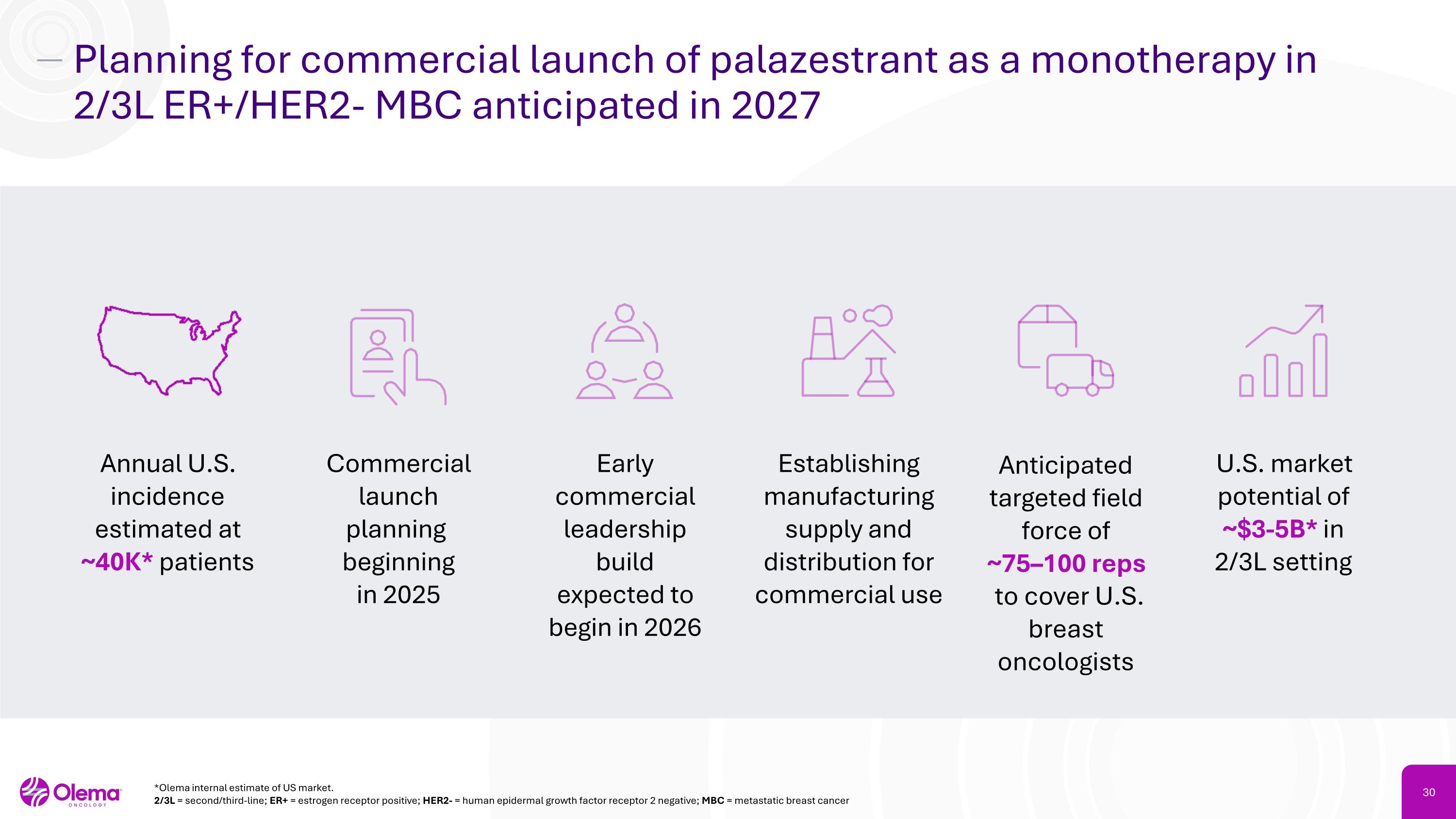
Planning for commercial launch of palazestrant as a monotherapy in 2/3L ER+/HER2- MBC anticipated in 2027 Annual U.S. incidence estimated at ~40K* patients Commercial launch planning beginning in 2025 Early commercial leadership build expected to begin in 2026 Establishing manufacturing supply and distribution for commercial use Anticipated targeted field force of ~75–100 reps to cover U.S. breast oncologists U.S. market potential of ~$3-5B* in 2/3L setting *Olema internal estimate of US market. 2/3L = second/third-line; ER+ = estrogen receptor positive; HER2- = human epidermal growth factor receptor 2 negative; MBC = metastatic breast cancer
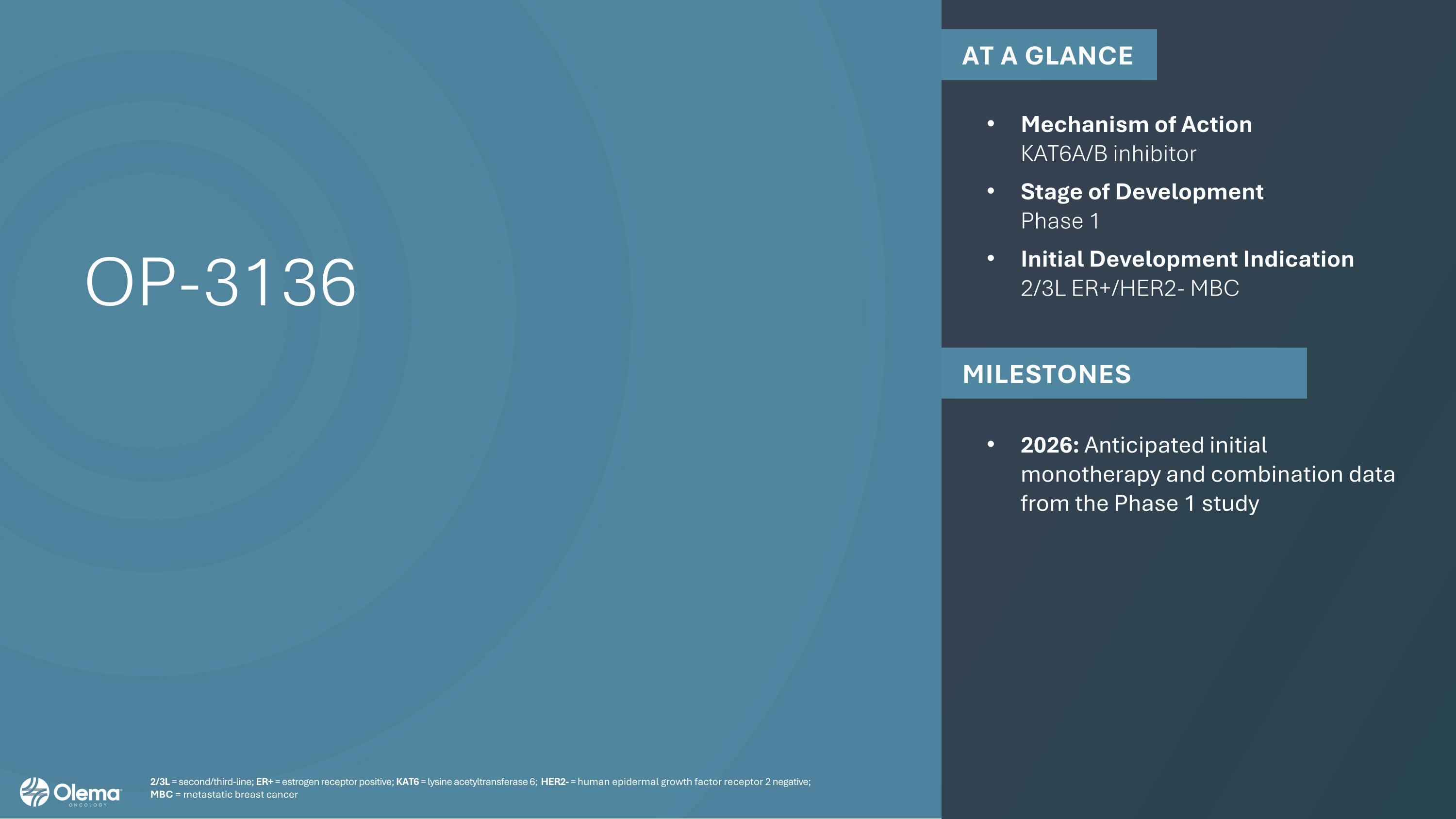
OP-3136 AT A GLANCE Mechanism of Action KAT6A/B inhibitor Stage of Development Phase 1 Initial Development Indication 2/3L ER+/HER2- MBC MILESTONES 2026: Anticipated initial monotherapy and combination data from the Phase 1 study 2/3L = second/third-line; ER+ = estrogen receptor positive; KAT6 = lysine acetyltransferase 6; HER2- = human epidermal growth factor receptor 2 negative; MBC = metastatic breast cancer
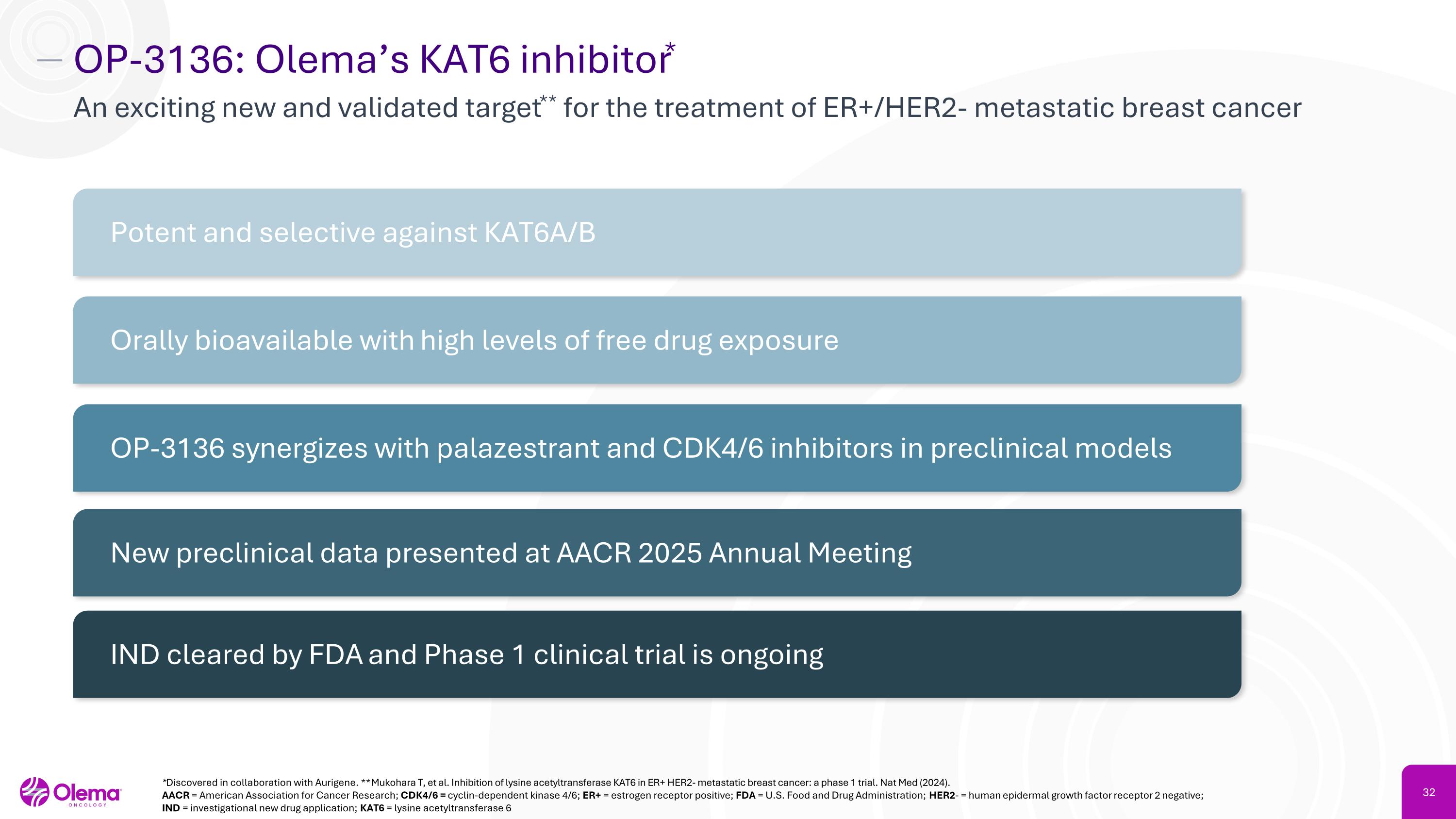
OP-3136: Olema’s KAT6 inhibitor* An exciting new and validated target** for the treatment of ER+/HER2- metastatic breast cancer Potent and selective against KAT6A/B Orally bioavailable with high levels of free drug exposure OP-3136 synergizes with palazestrant and CDK4/6 inhibitors in preclinical models New preclinical data presented at AACR 2025 Annual Meeting IND cleared by FDA and Phase 1 clinical trial is ongoing *Discovered in collaboration with Aurigene. **Mukohara T, et al. Inhibition of lysine acetyltransferase KAT6 in ER+ HER2- metastatic breast cancer: a phase 1 trial. Nat Med (2024). AACR = American Association for Cancer Research; CDK4/6 = cyclin-dependent kinase 4/6; ER+ = estrogen receptor positive; FDA = U.S. Food and Drug Administration; HER2- = human epidermal growth factor receptor 2 negative; IND = investigational new drug application; KAT6 = lysine acetyltransferase 6
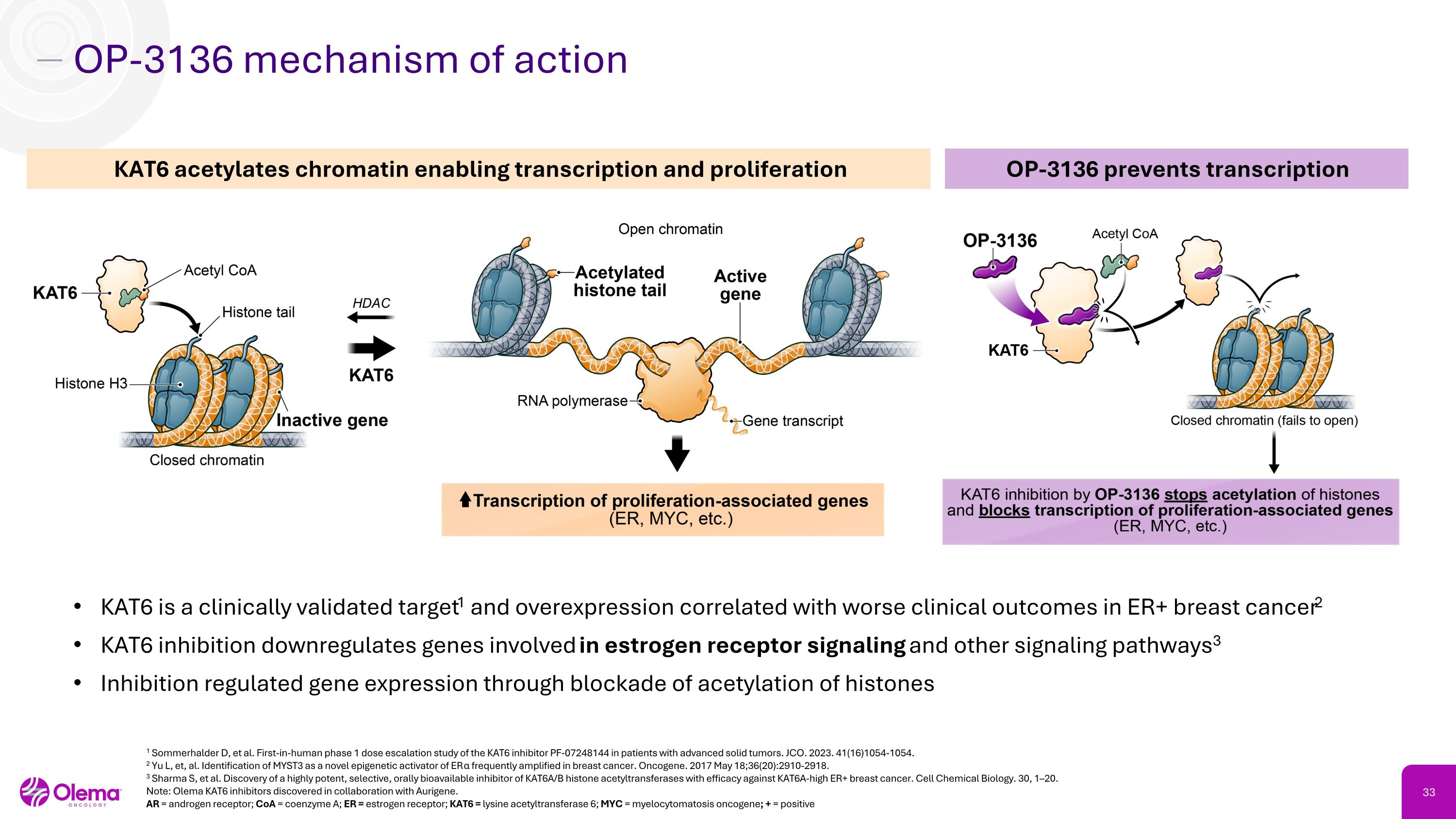
OP-3136 mechanism of action KAT6 is a clinically validated target1 and overexpression correlated with worse clinical outcomes in ER+ breast cancer2 KAT6 inhibition downregulates genes involved in estrogen receptor signaling and other signaling pathways3 Inhibition regulated gene expression through blockade of acetylation of histones KAT6 acetylates chromatin enabling transcription and proliferation OP-3136 prevents transcription 1 Sommerhalder D, et al. First-in-human phase 1 dose escalation study of the KAT6 inhibitor PF-07248144 in patients with advanced solid tumors. JCO. 2023. 41(16)1054-1054. 2 Yu L, et, al. Identification of MYST3 as a novel epigenetic activator of ERα frequently amplified in breast cancer. Oncogene. 2017 May 18;36(20):2910-2918. 3 Sharma S, et al. Discovery of a highly potent, selective, orally bioavailable inhibitor of KAT6A/B histone acetyltransferases with efficacy against KAT6A-high ER+ breast cancer. Cell Chemical Biology. 30, 1–20. Note: Olema KAT6 inhibitors discovered in collaboration with Aurigene. AR = androgen receptor; CoA = coenzyme A; ER = estrogen receptor; KAT6 = lysine acetyltransferase 6; MYC = myelocytomatosis oncogene; + = positive
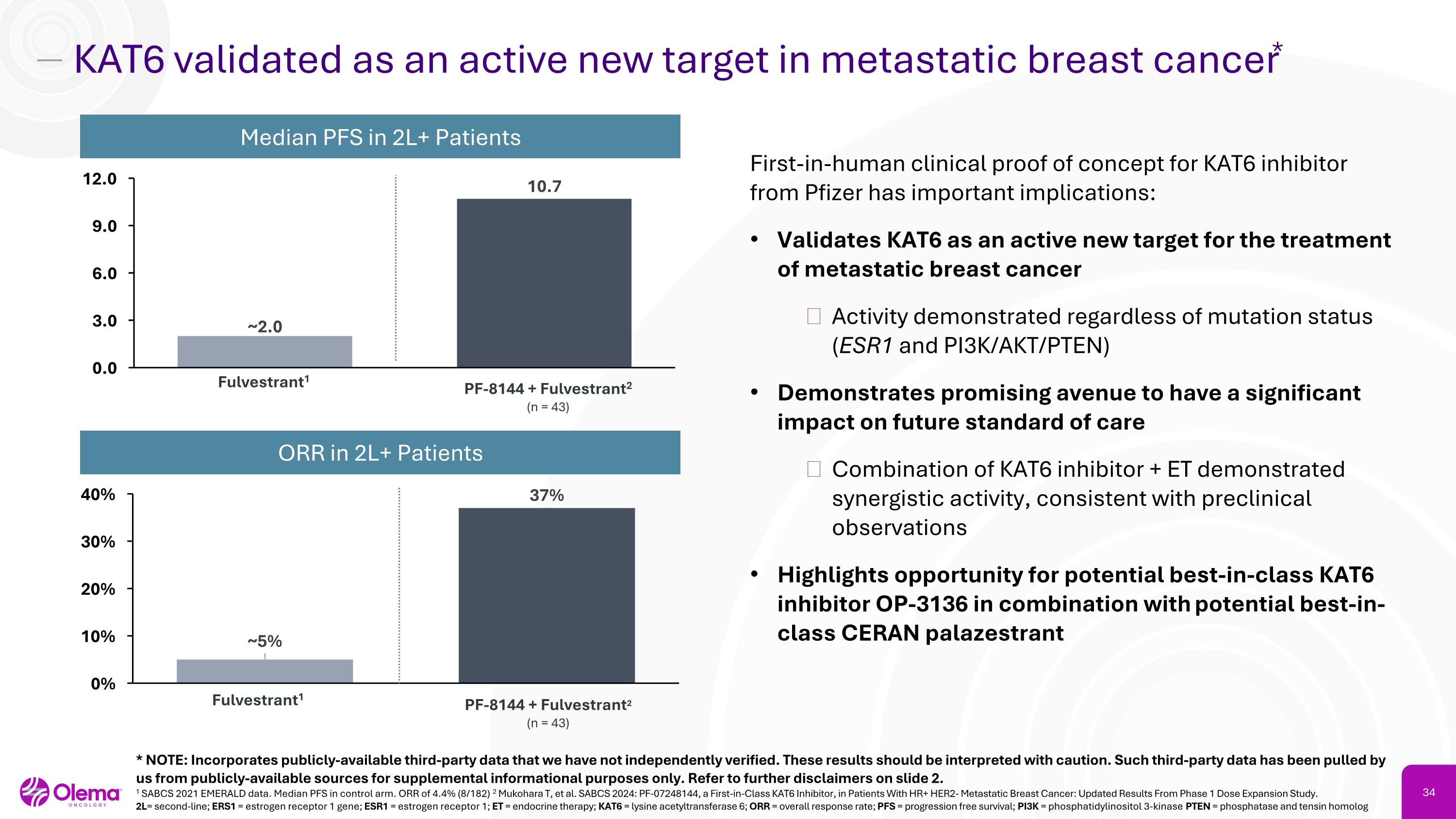
KAT6 validated as an active new target in metastatic breast cancer* * NOTE: Incorporates publicly-available third-party data that we have not independently verified. These results should be interpreted with caution. Such third-party data has been pulled by us from publicly-available sources for supplemental informational purposes only. Refer to further disclaimers on slide 2. 1 SABCS 2021 EMERALD data. Median PFS in control arm. ORR of 4.4% (8/182) 2 Mukohara T, et al. SABCS 2024: PF-07248144, a First-in-Class KAT6 Inhibitor, in Patients With HR+ HER2- Metastatic Breast Cancer: Updated Results From Phase 1 Dose Expansion Study. 2L= second-line; ERS1 = estrogen receptor 1 gene; ESR1 = estrogen receptor 1; ET = endocrine therapy; KAT6 = lysine acetyltransferase 6; ORR = overall response rate; PFS = progression free survival; PI3K = phosphatidylinositol 3-kinase PTEN = phosphatase and tensin homolog Median PFS in 2L+ Patients Fulvestrant1 PF-8144 + Fulvestrant2 (n = 43) ORR in 2L+ Patients First-in-human clinical proof of concept for KAT6 inhibitor from Pfizer has important implications: Validates KAT6 as an active new target for the treatment of metastatic breast cancer Activity demonstrated regardless of mutation status (ESR1 and PI3K/AKT/PTEN) Demonstrates promising avenue to have a significant impact on future standard of care Combination of KAT6 inhibitor + ET demonstrated synergistic activity, consistent with preclinical observations Highlights opportunity for potential best-in-class KAT6 inhibitor OP-3136 in combination with potential best-in-class CERAN palazestrant PF-8144 + Fulvestrant2 (n = 43) Fulvestrant1
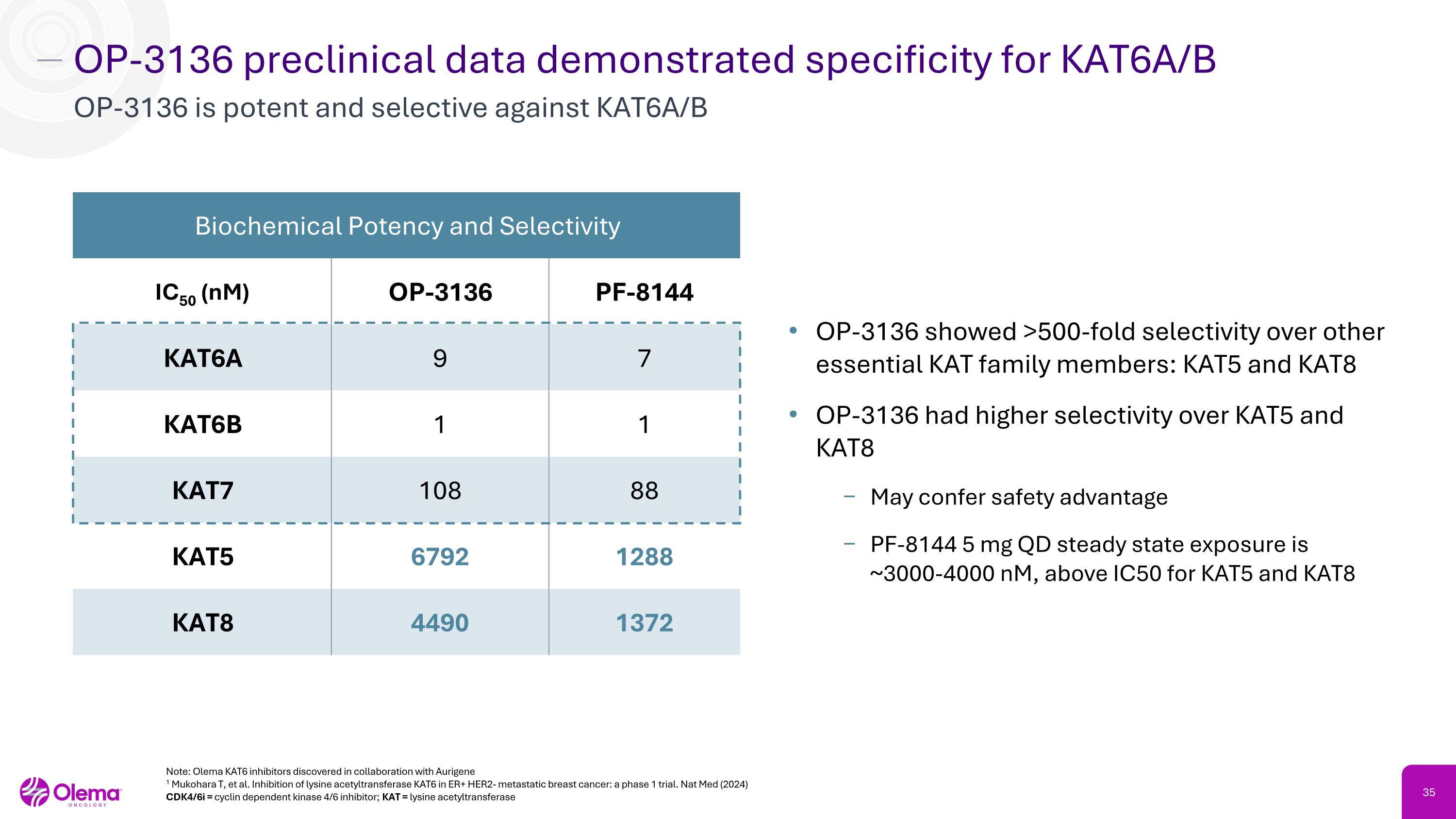
OP-3136 preclinical data demonstrated specificity for KAT6A/B OP-3136 is potent and selective against KAT6A/B Note: Olema KAT6 inhibitors discovered in collaboration with Aurigene 1 Mukohara T, et al. Inhibition of lysine acetyltransferase KAT6 in ER+ HER2- metastatic breast cancer: a phase 1 trial. Nat Med (2024) CDK4/6i = cyclin dependent kinase 4/6 inhibitor; KAT = lysine acetyltransferase OP-3136 showed >500-fold selectivity over other essential KAT family members: KAT5 and KAT8 OP-3136 had higher selectivity over KAT5 and KAT8 May confer safety advantage PF-8144 5 mg QD steady state exposure is ~3000-4000 nM, above IC50 for KAT5 and KAT8 Biochemical Potency and Selectivity IC50 (nM) OP-3136 PF-8144 KAT6A 9 7 KAT6B 1 1 KAT7 108 88 KAT5 6792 1288 KAT8 4490 1372
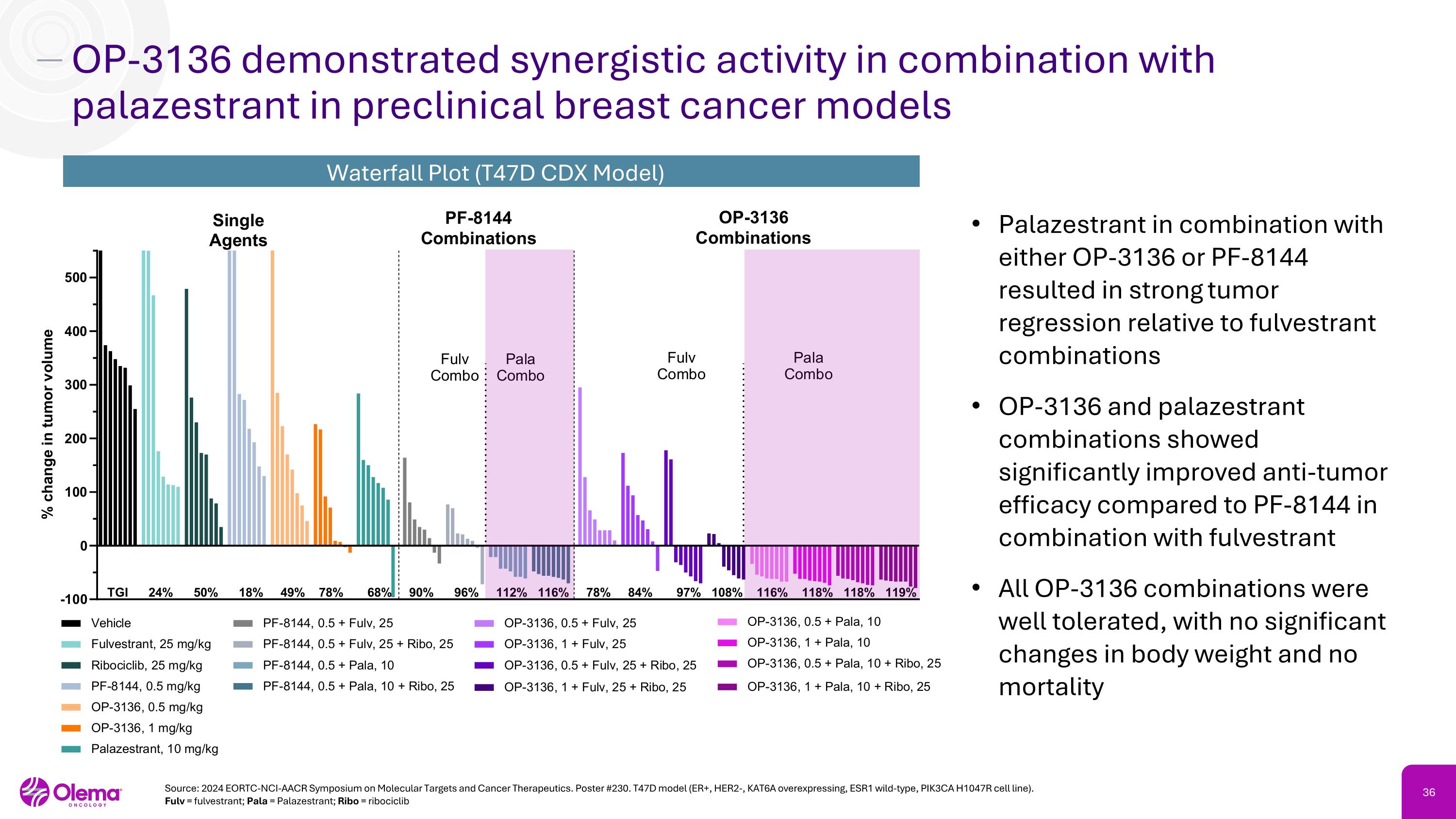
OP-3136 demonstrated synergistic activity in combination with palazestrant in preclinical breast cancer models Waterfall Plot (T47D CDX Model) Palazestrant in combination with either OP-3136 or PF-8144 resulted in strong tumor regression relative to fulvestrant combinations OP-3136 and palazestrant combinations showed significantly improved anti-tumor efficacy compared to PF-8144 in combination with fulvestrant All OP-3136 combinations were well tolerated, with no significant changes in body weight and no mortality Source: 2024 EORTC-NCI-AACR Symposium on Molecular Targets and Cancer Therapeutics. Poster #230. T47D model (ER+, HER2-, KAT6A overexpressing, ESR1 wild-type, PIK3CA H1047R cell line). Fulv = fulvestrant; Pala = Palazestrant; Ribo = ribociclib
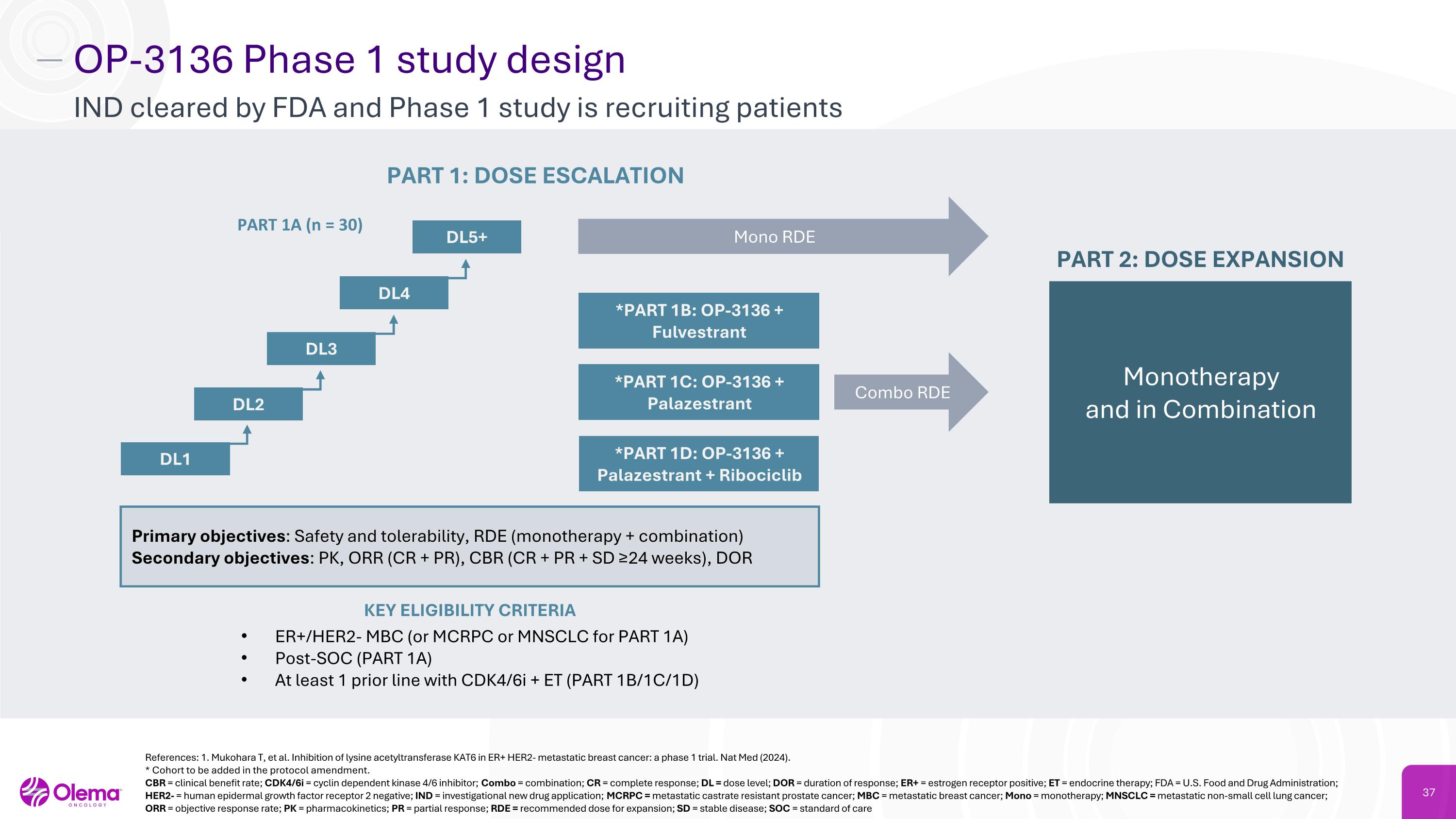
OP-3136 Phase 1 study design IND cleared by FDA and Phase 1 study is recruiting patients Primary objectives: Safety and tolerability, RDE (monotherapy + combination) Secondary objectives: PK, ORR (CR + PR), CBR (CR + PR + SD ≥24 weeks), DOR PART 1: DOSE ESCALATION DL1 DL2 DL3 DL4 Mono RDE ER+/HER2- MBC (or MCRPC or MNSCLC for PART 1A) Post-SOC (PART 1A) At least 1 prior line with CDK4/6i + ET (PART 1B/1C/1D) KEY ELIGIBILITY CRITERIA *PART 1B: OP-3136 + Fulvestrant *PART 1C: OP-3136 + Palazestrant *PART 1D: OP-3136 + Palazestrant + Ribociclib Combo RDE PART 1A (n = 30) References: 1. Mukohara T, et al. Inhibition of lysine acetyltransferase KAT6 in ER+ HER2- metastatic breast cancer: a phase 1 trial. Nat Med (2024). * Cohort to be added in the protocol amendment. CBR = clinical benefit rate; CDK4/6i = cyclin dependent kinase 4/6 inhibitor; Combo = combination; CR = complete response; DL = dose level; DOR = duration of response; ER+ = estrogen receptor positive; ET = endocrine therapy; FDA = U.S. Food and Drug Administration; HER2- = human epidermal growth factor receptor 2 negative; IND = investigational new drug application; MCRPC = metastatic castrate resistant prostate cancer; MBC = metastatic breast cancer; Mono = monotherapy; MNSCLC = metastatic non-small cell lung cancer; ORR = objective response rate; PK = pharmacokinetics; PR = partial response; RDE = recommended dose for expansion; SD = stable disease; SOC = standard of care DL5+ Monotherapy and in Combination PART 2: DOSE EXPANSION
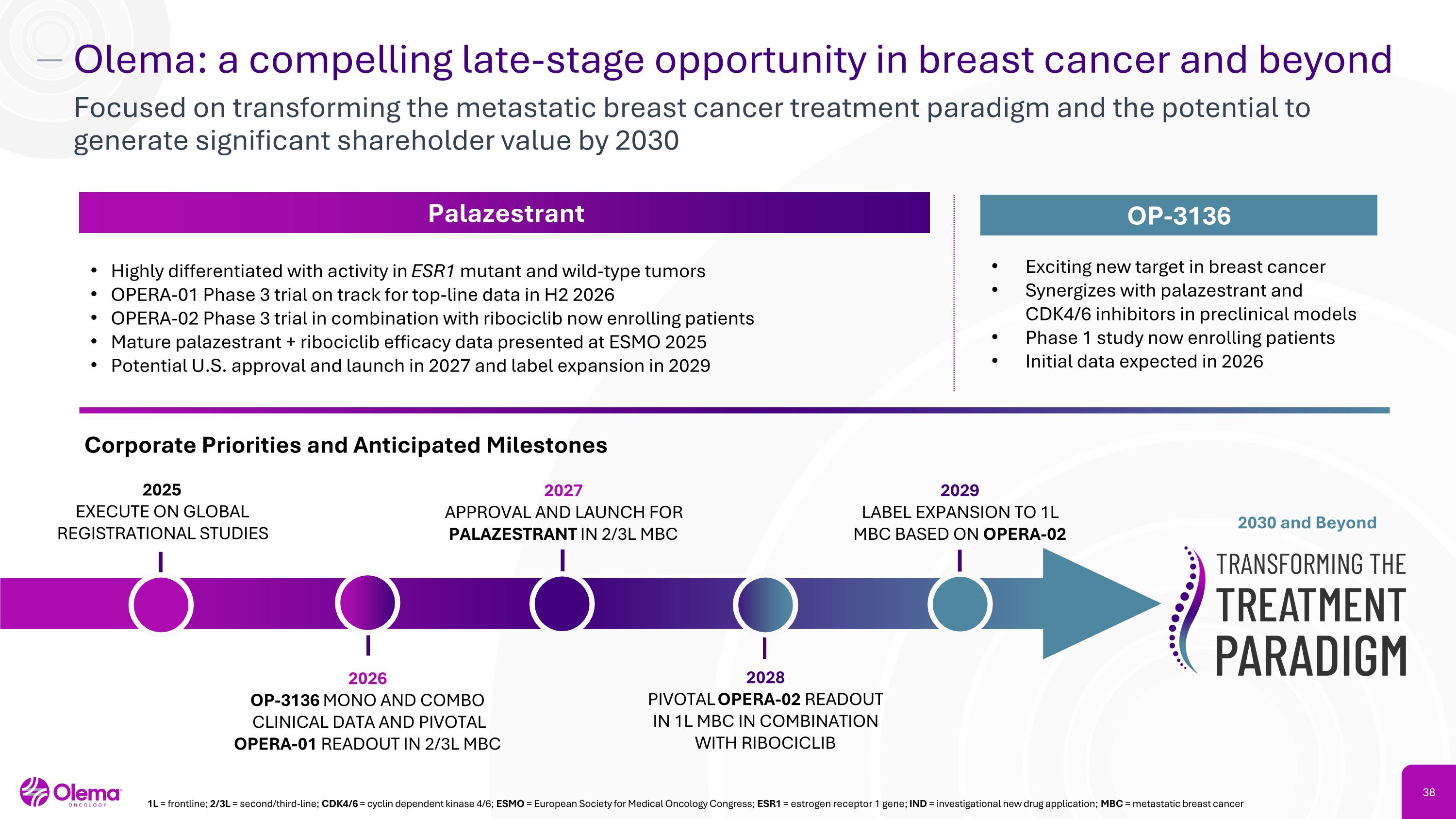
Olema: a compelling late-stage opportunity in breast cancer and beyond Focused on transforming the metastatic breast cancer treatment paradigm and the potential to generate significant shareholder value by 2030 1L = frontline; 2/3L = second/third-line; CDK4/6 = cyclin dependent kinase 4/6; ESMO = European Society for Medical Oncology Congress; ESR1 = estrogen receptor 1 gene; IND = investigational new drug application; MBC = metastatic breast cancer 2025 EXECUTE ON GLOBAL REGISTRATIONAL STUDIES 2027 APPROVAL AND LAUNCH FOR PALAZESTRANT IN 2/3L MBC 2028 PIVOTAL OPERA-02 READOUT IN 1L MBC IN COMBINATION WITH RIBOCICLIB 2026 OP-3136 MONO AND COMBO CLINICAL DATA AND PIVOTAL OPERA-01 READOUT IN 2/3L MBC 2029 LABEL EXPANSION TO 1L MBC BASED ON OPERA-02 2030 and Beyond Palazestrant OP-3136 Highly differentiated with activity in ESR1 mutant and wild-type tumors OPERA-01 Phase 3 trial on track for top-line data in H2 2026 OPERA-02 Phase 3 trial in combination with ribociclib now enrolling patients Mature palazestrant + ribociclib efficacy data presented at ESMO 2025 Potential U.S. approval and launch in 2027 and label expansion in 2029 Exciting new target in breast cancer Synergizes with palazestrant and CDK4/6 inhibitors in preclinical models Phase 1 study now enrolling patients Initial data expected in 2026 Corporate Priorities and Anticipated Milestones
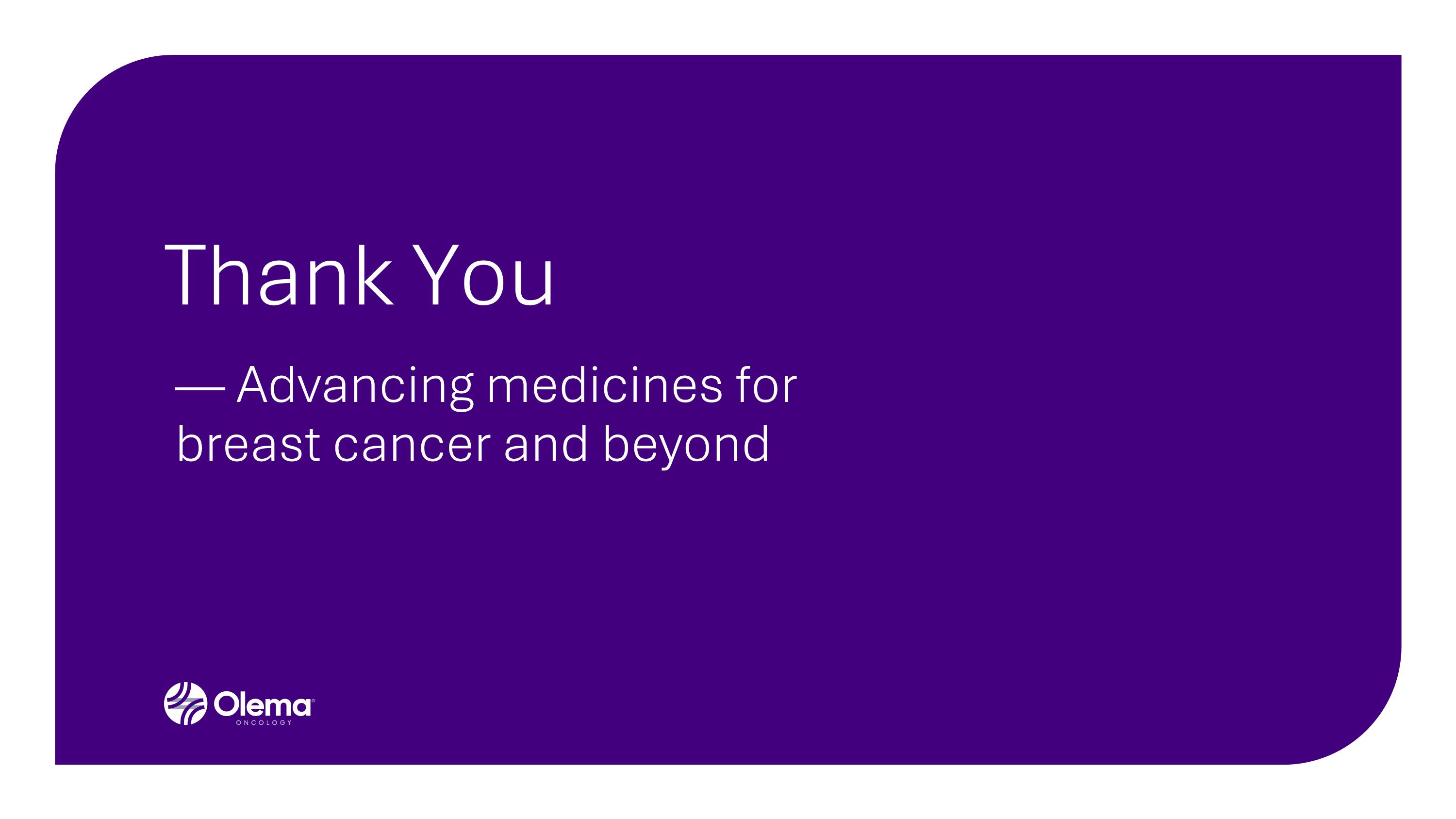
— Advancing medicines for breast cancer and beyond